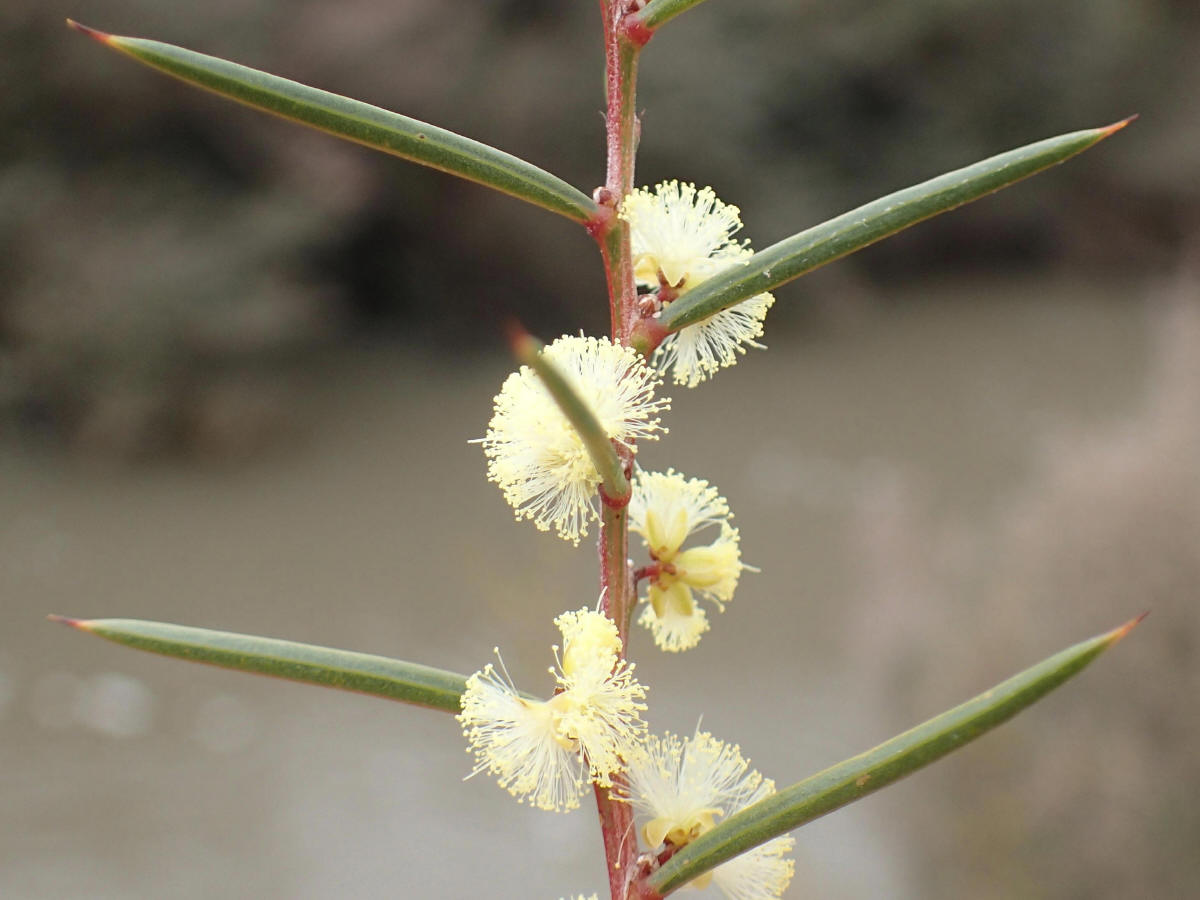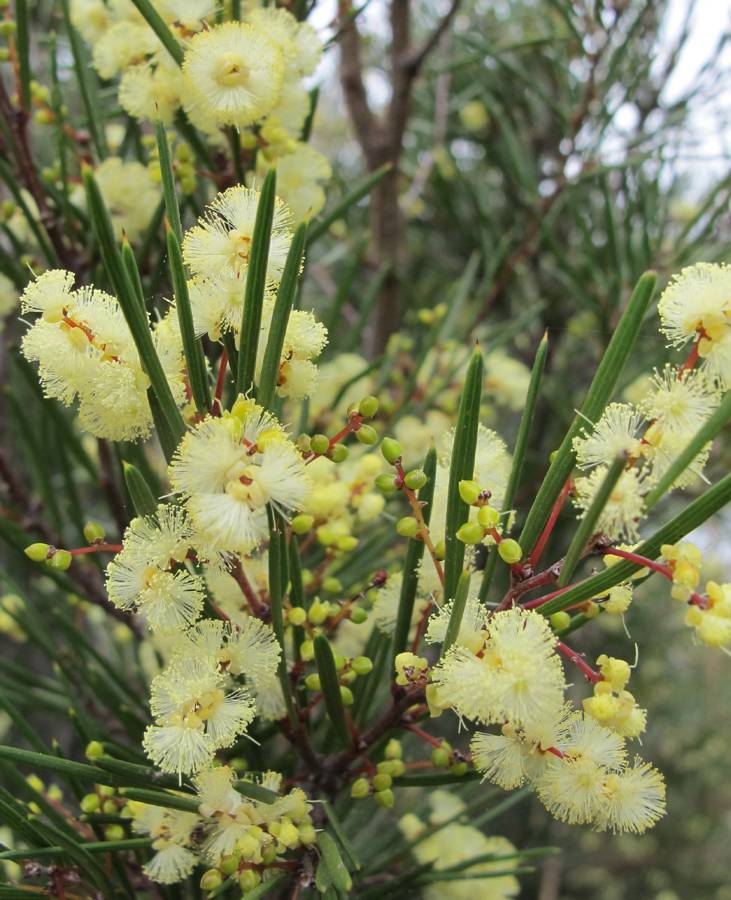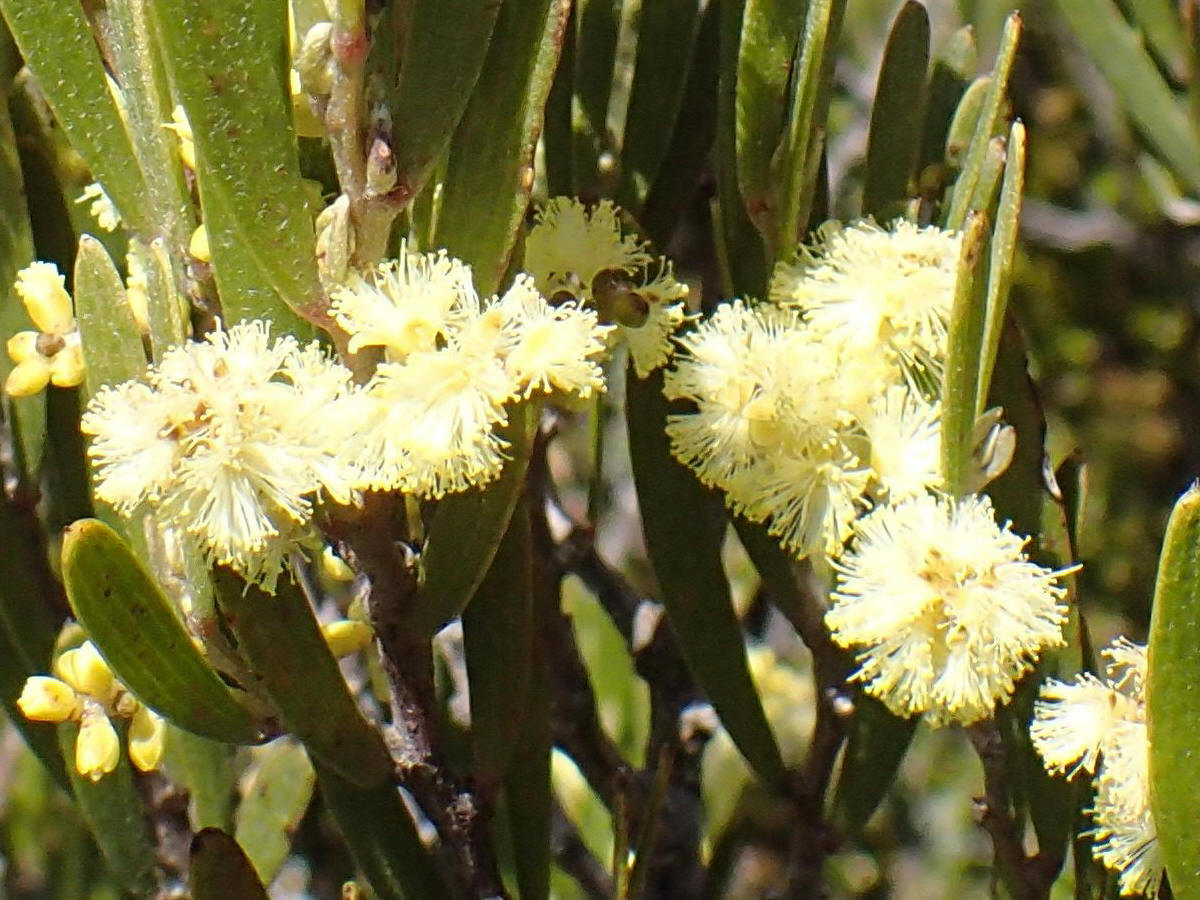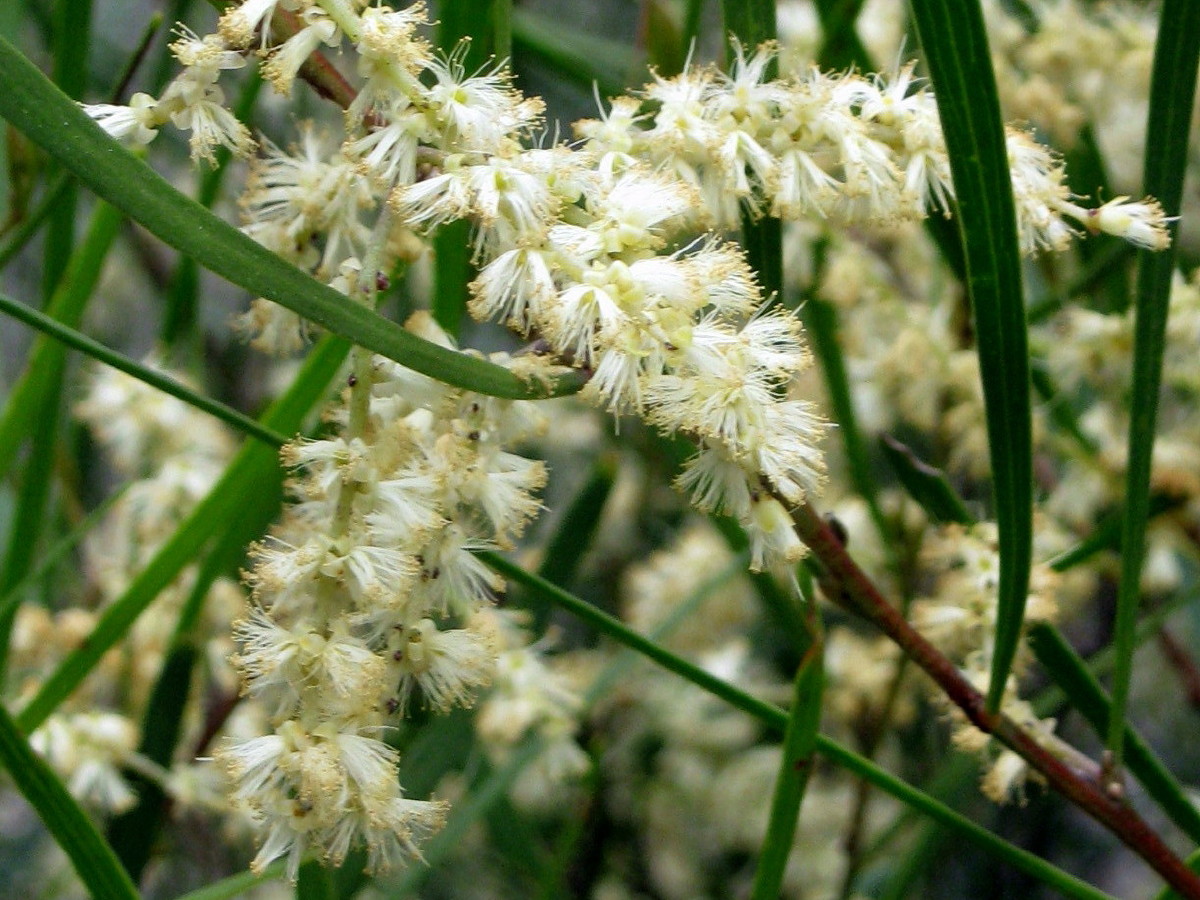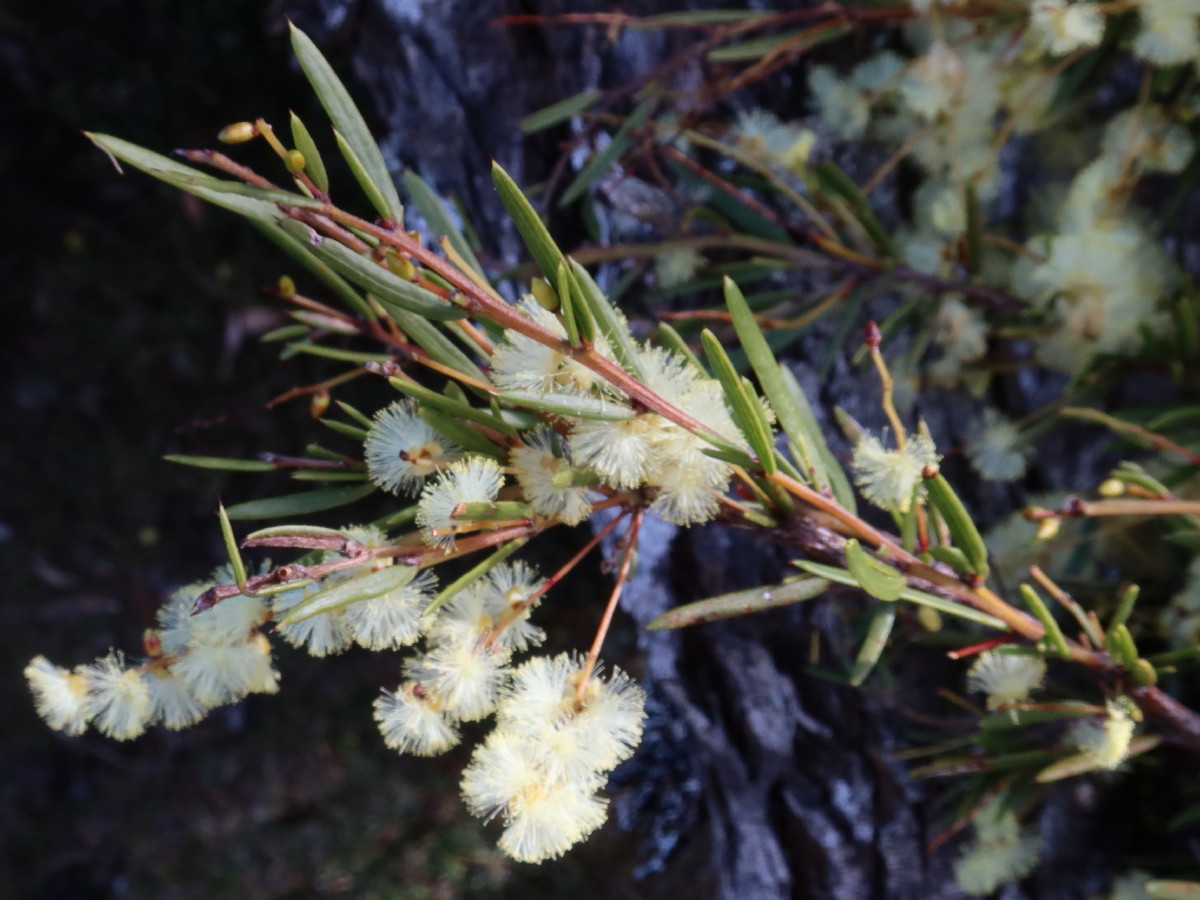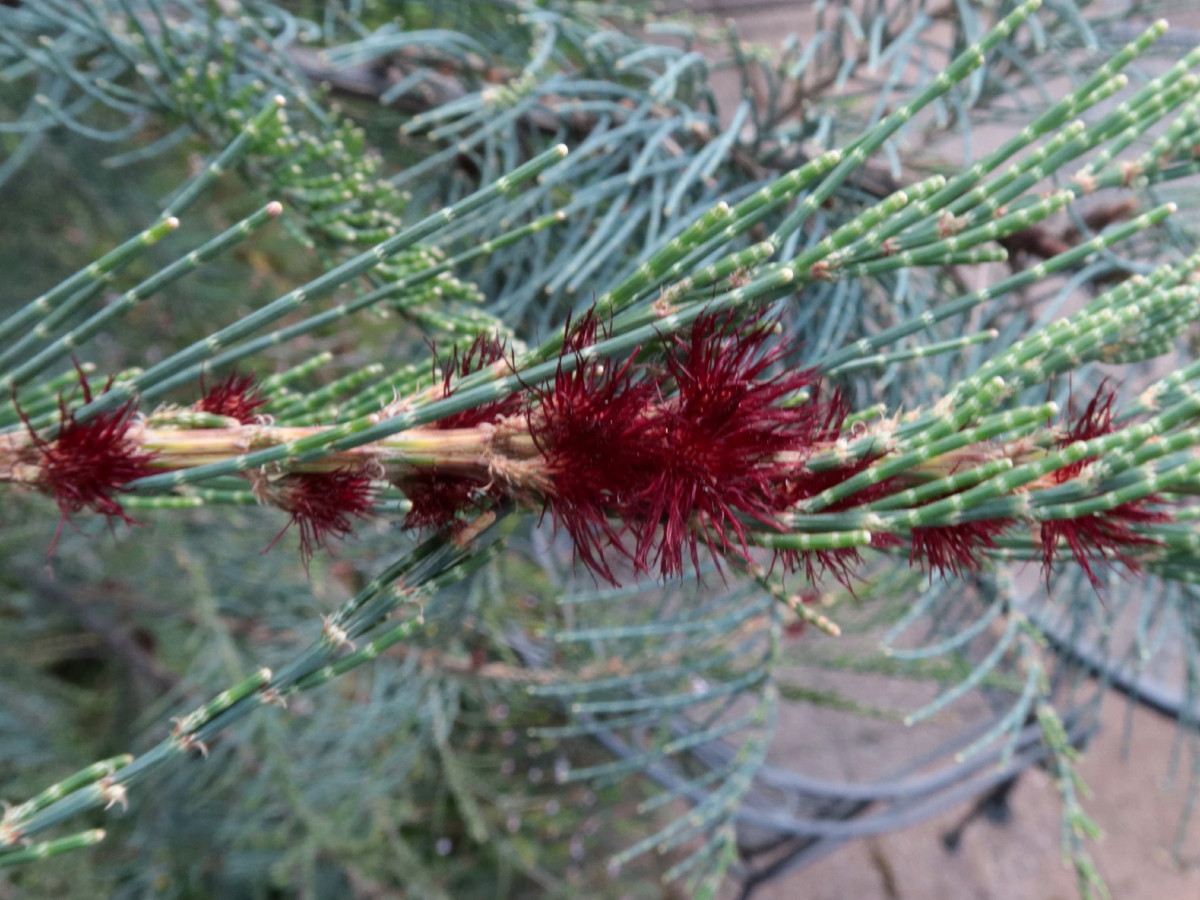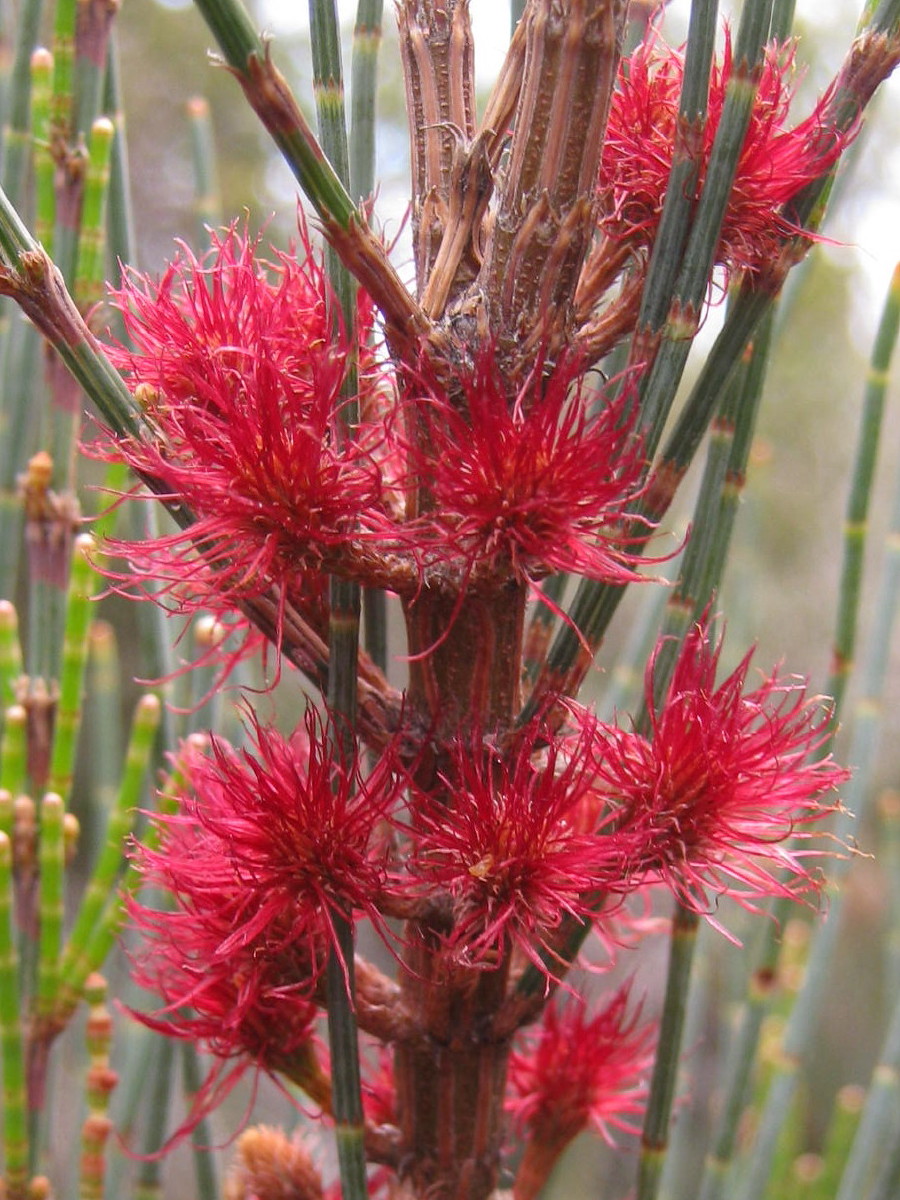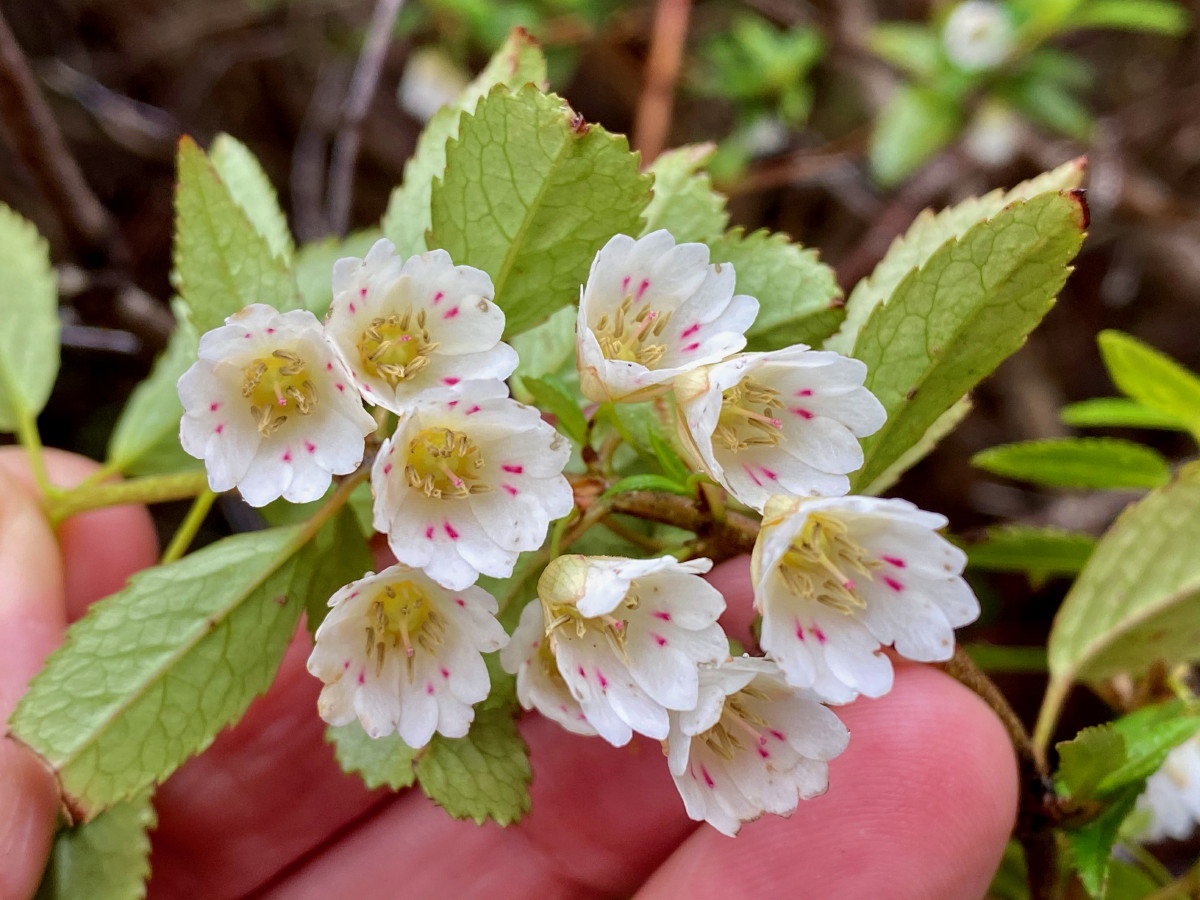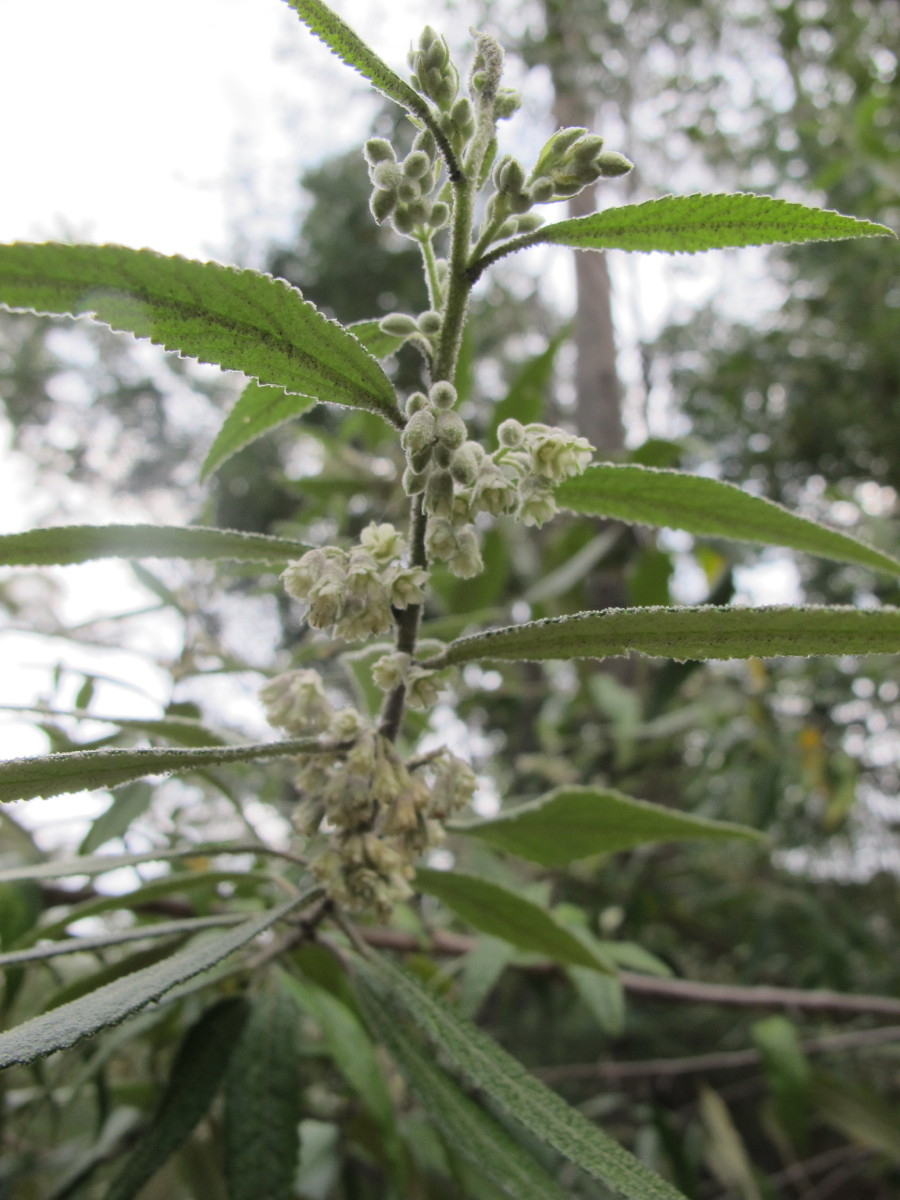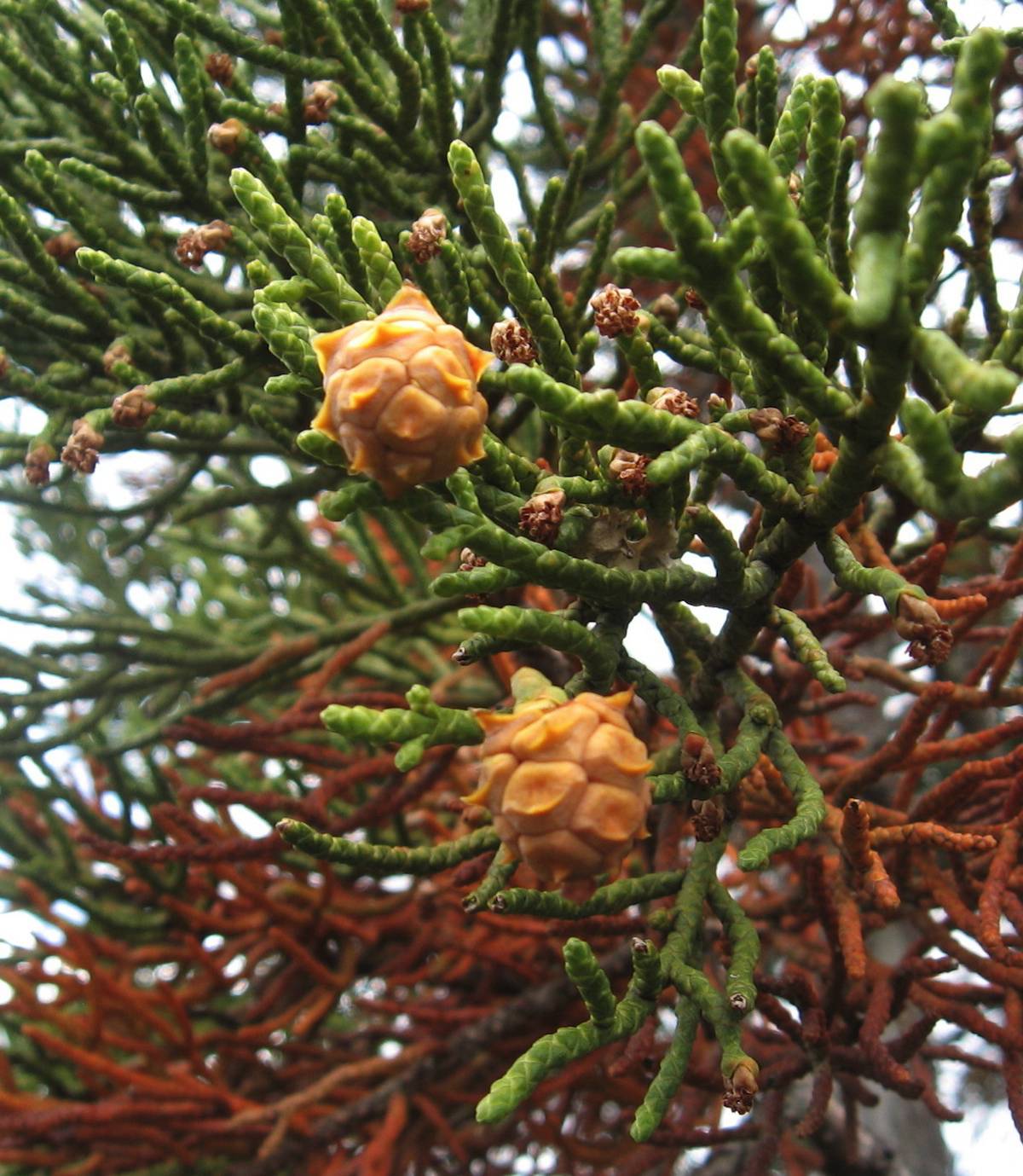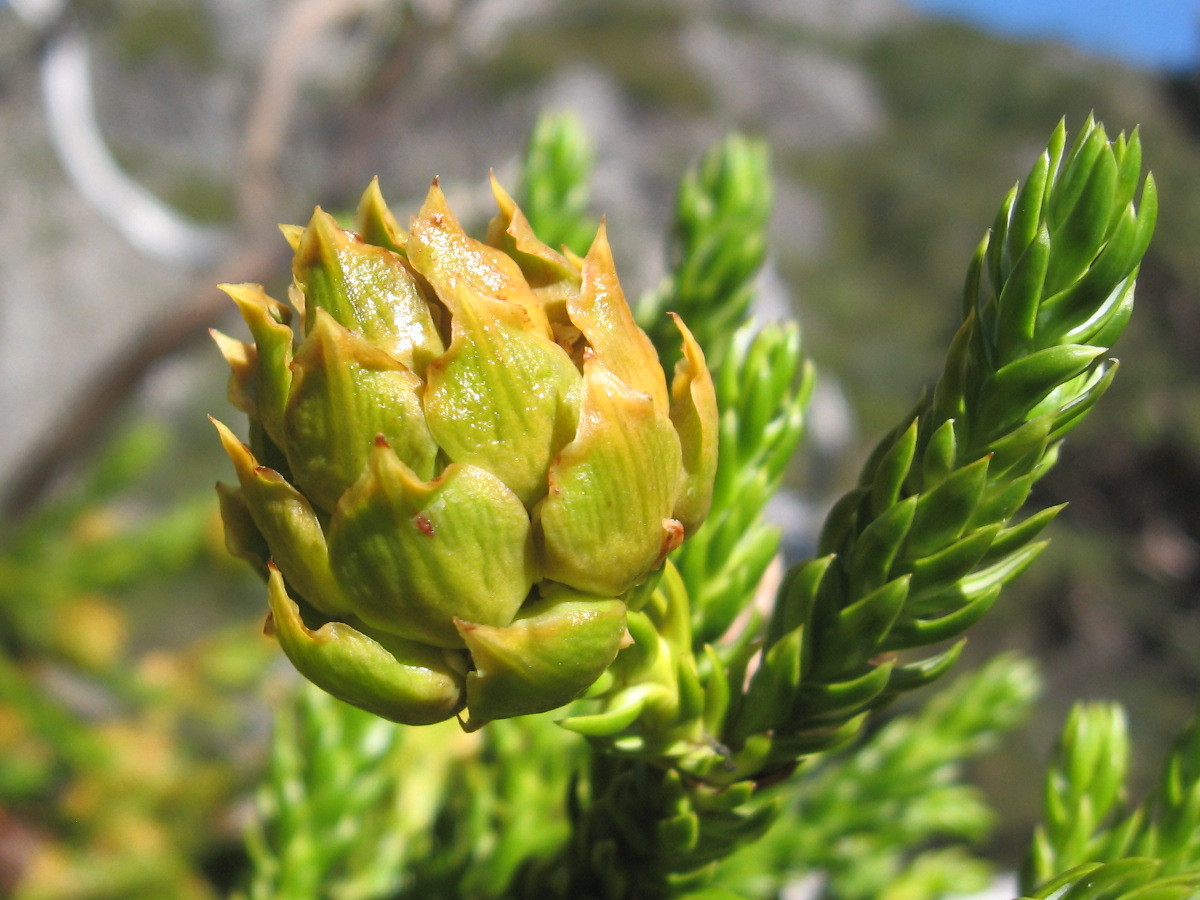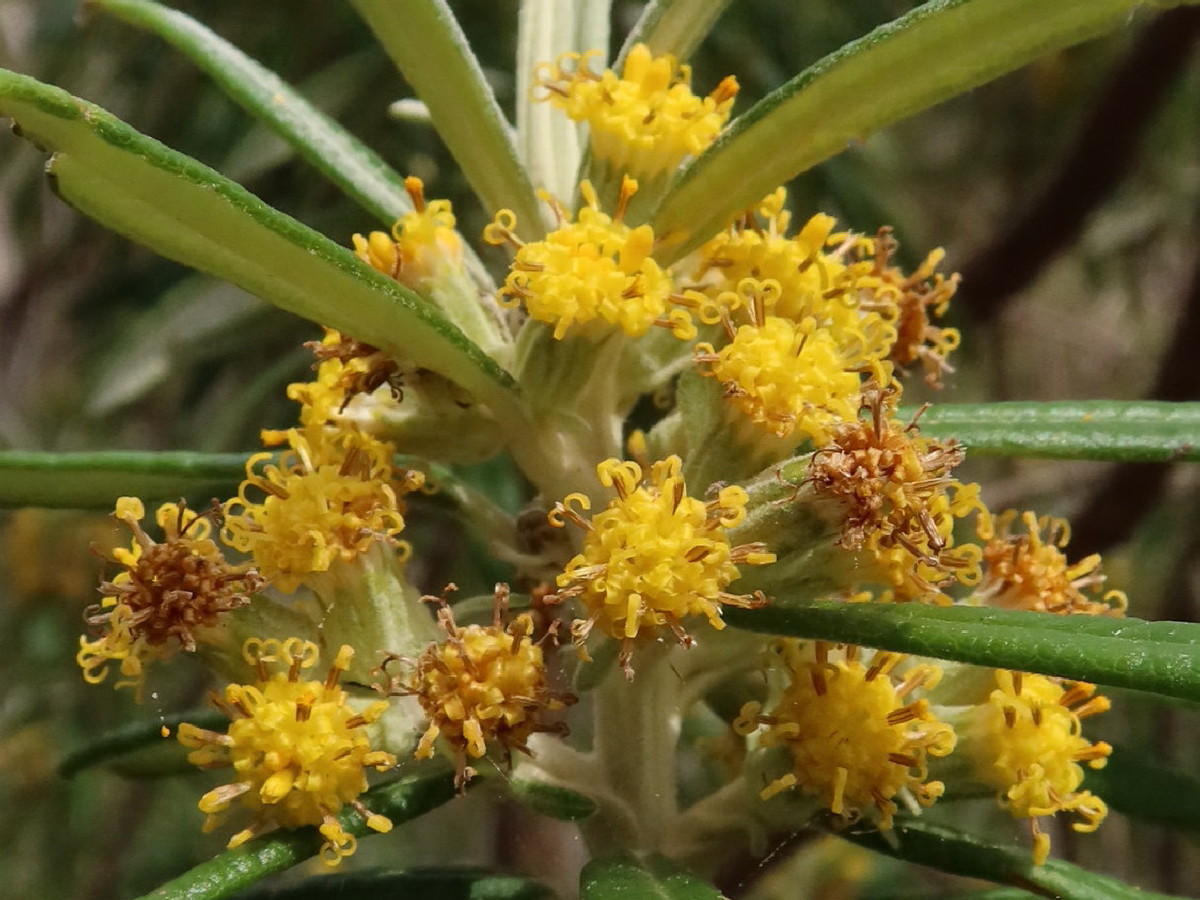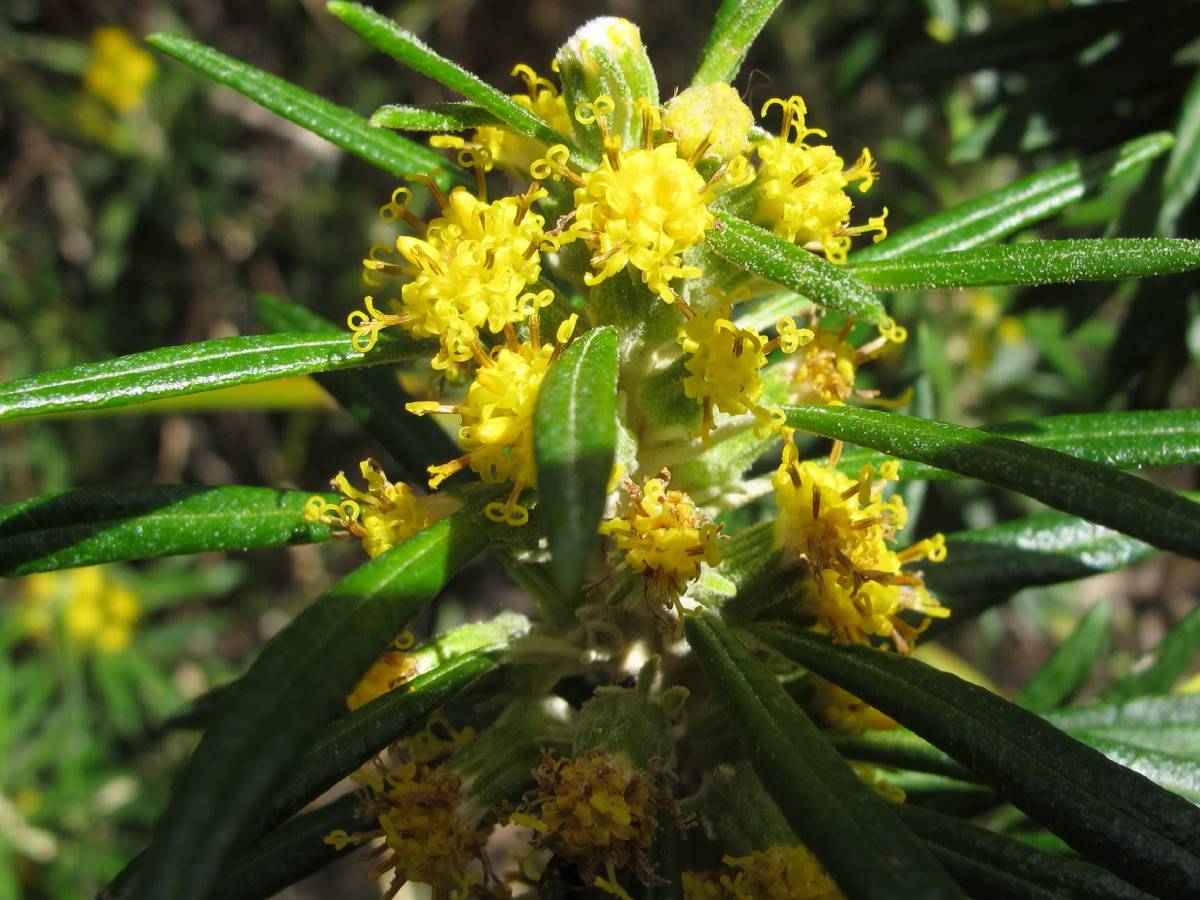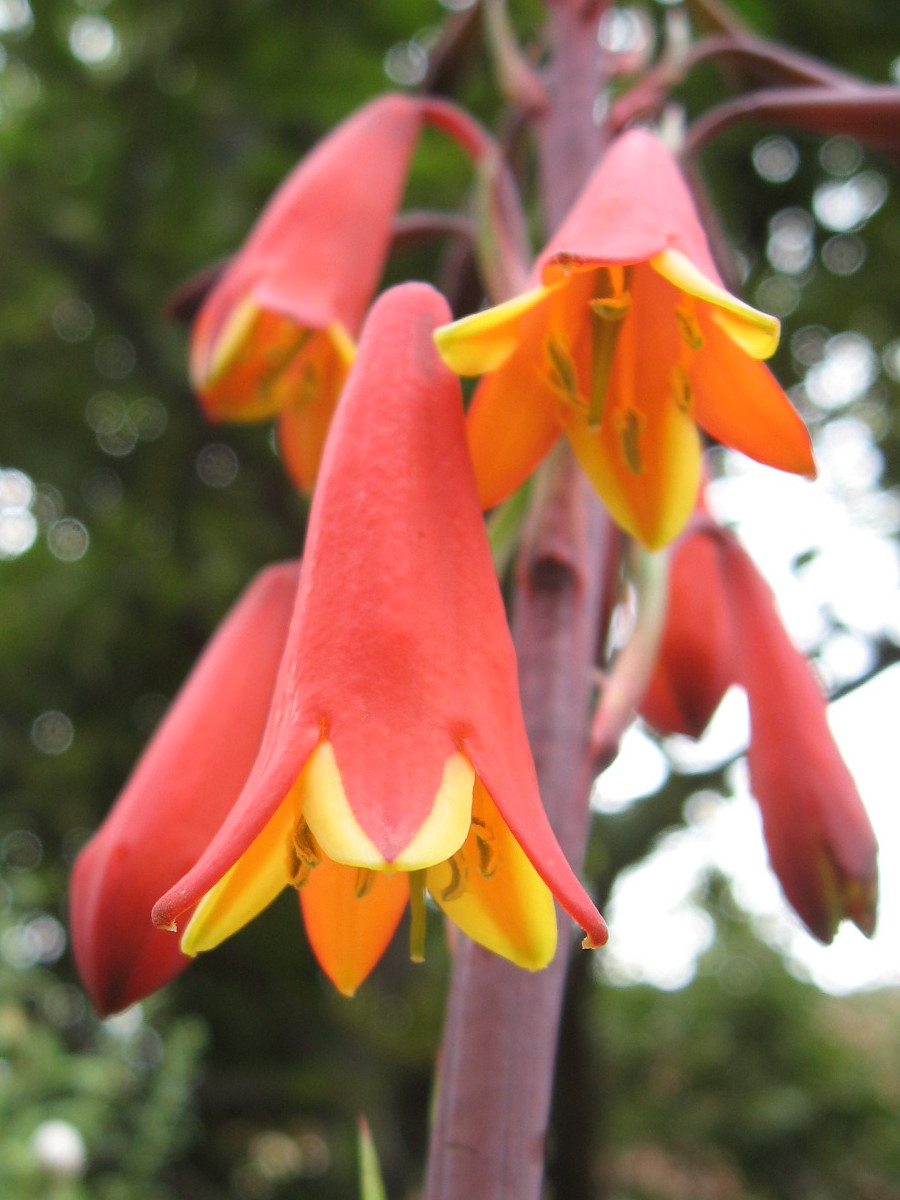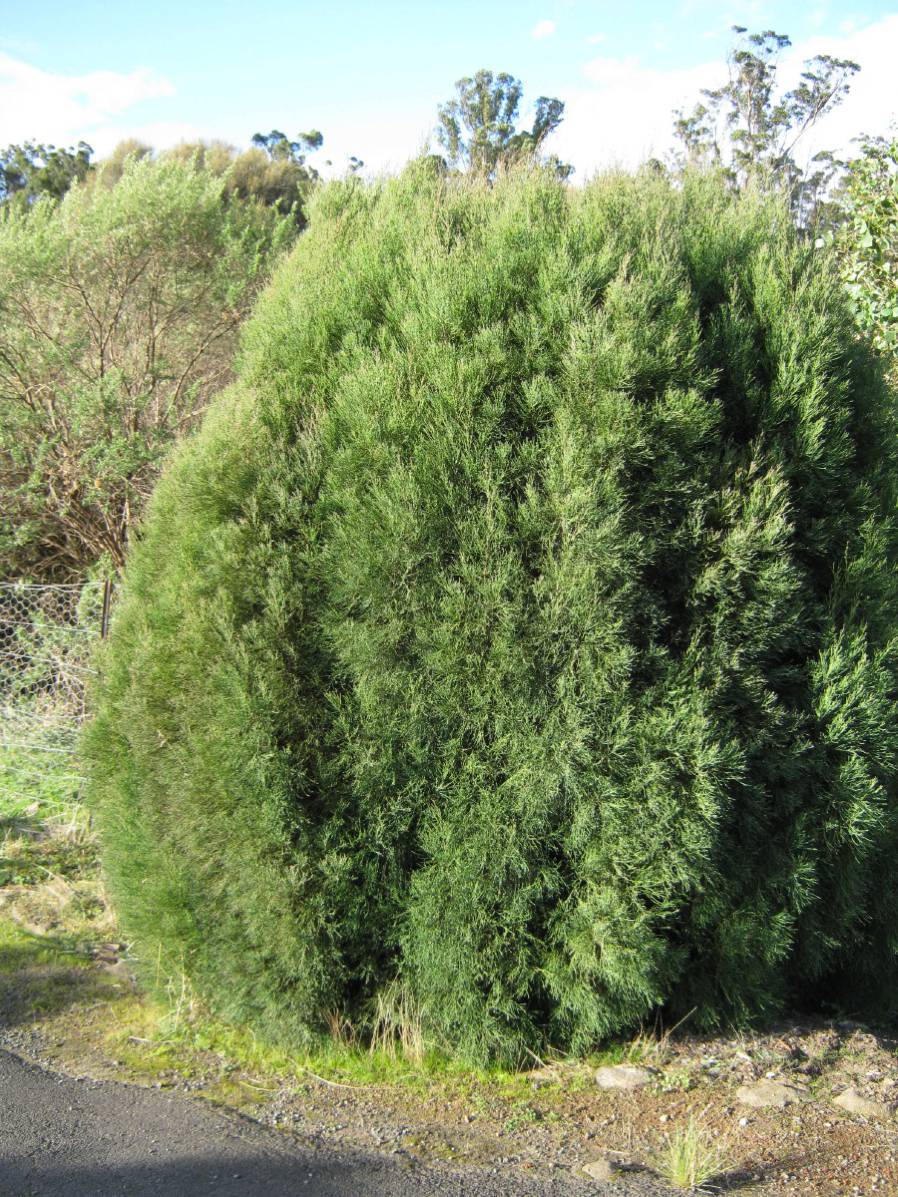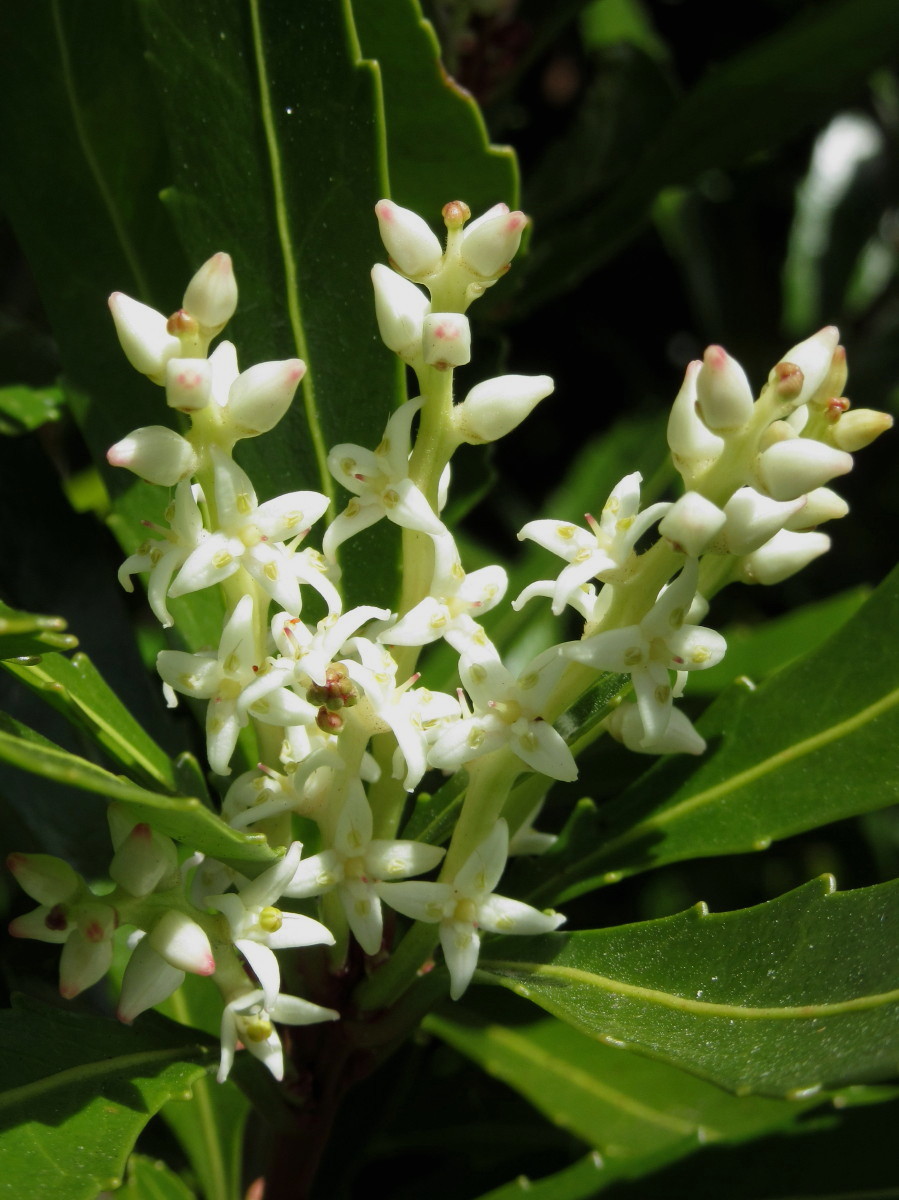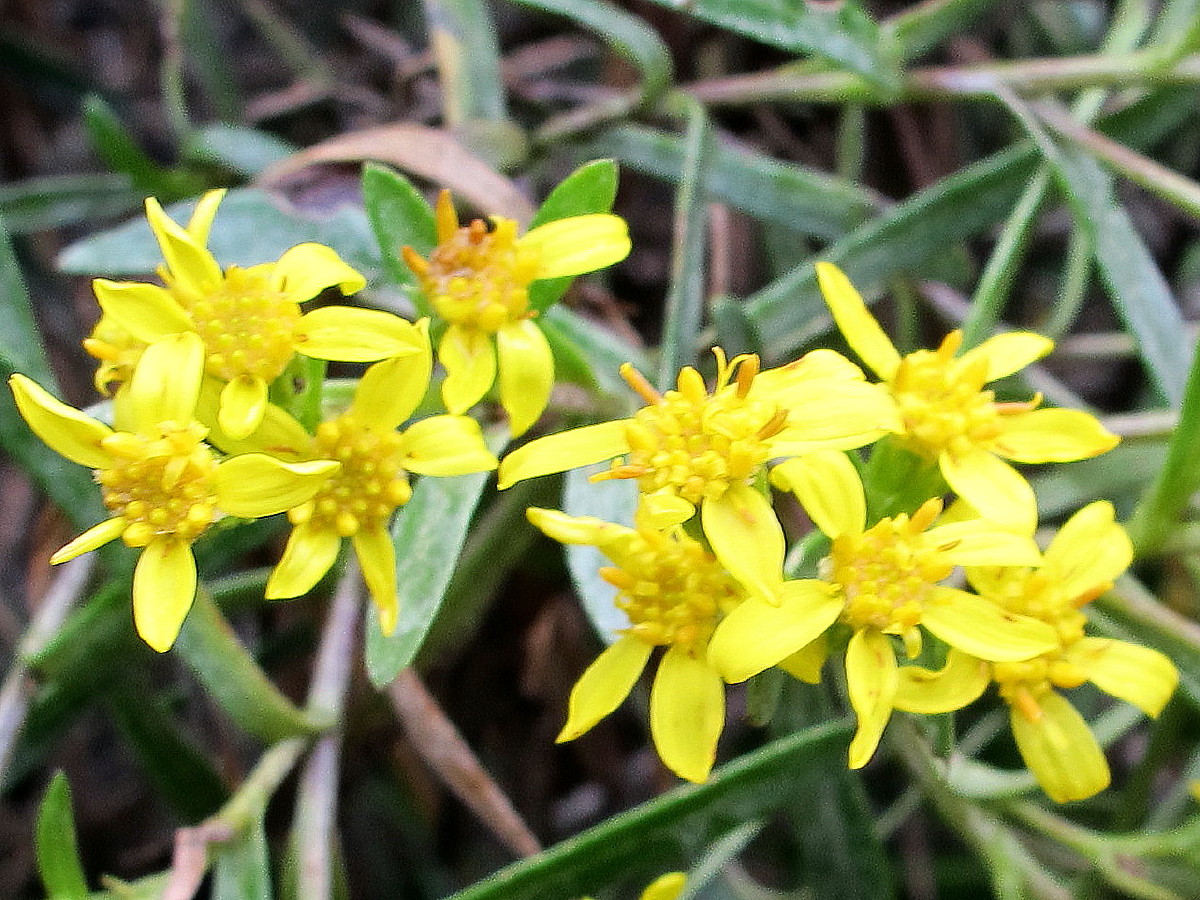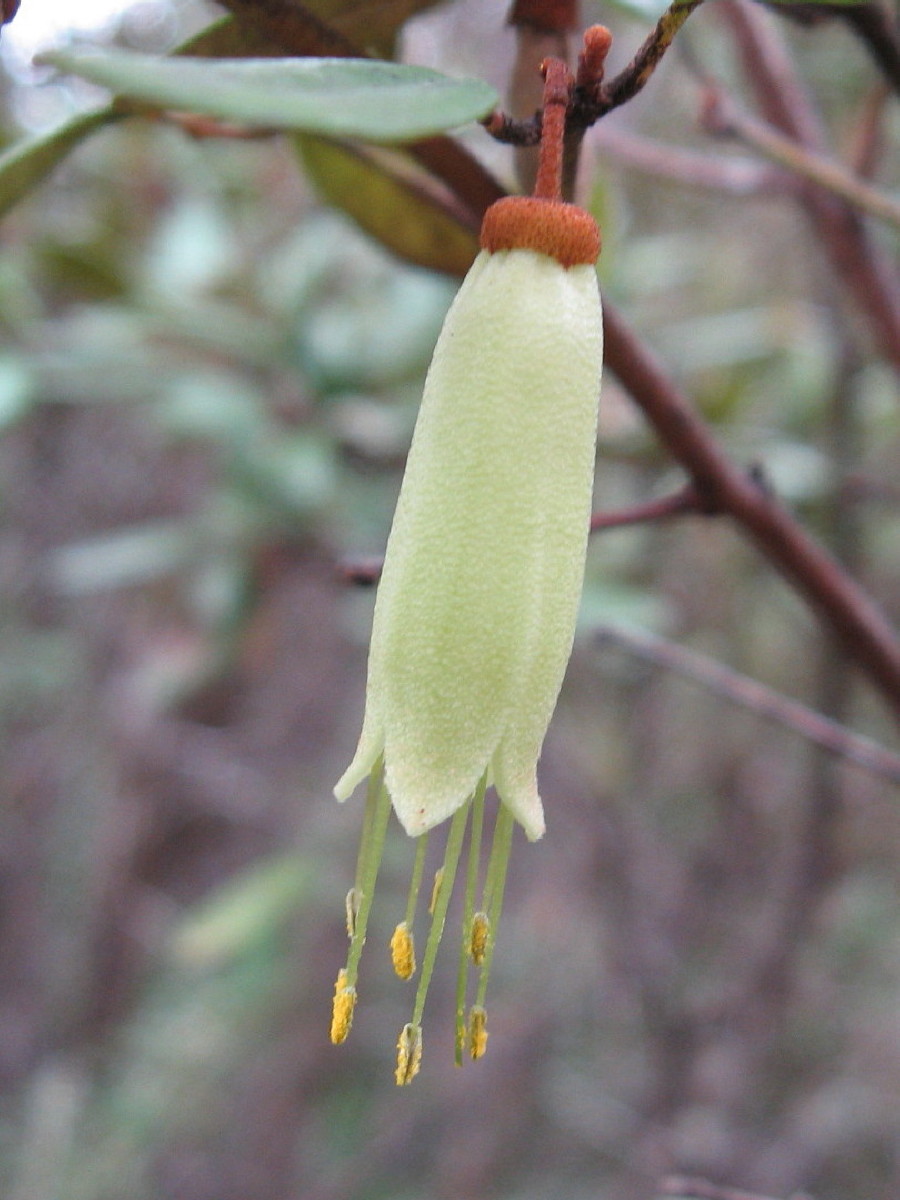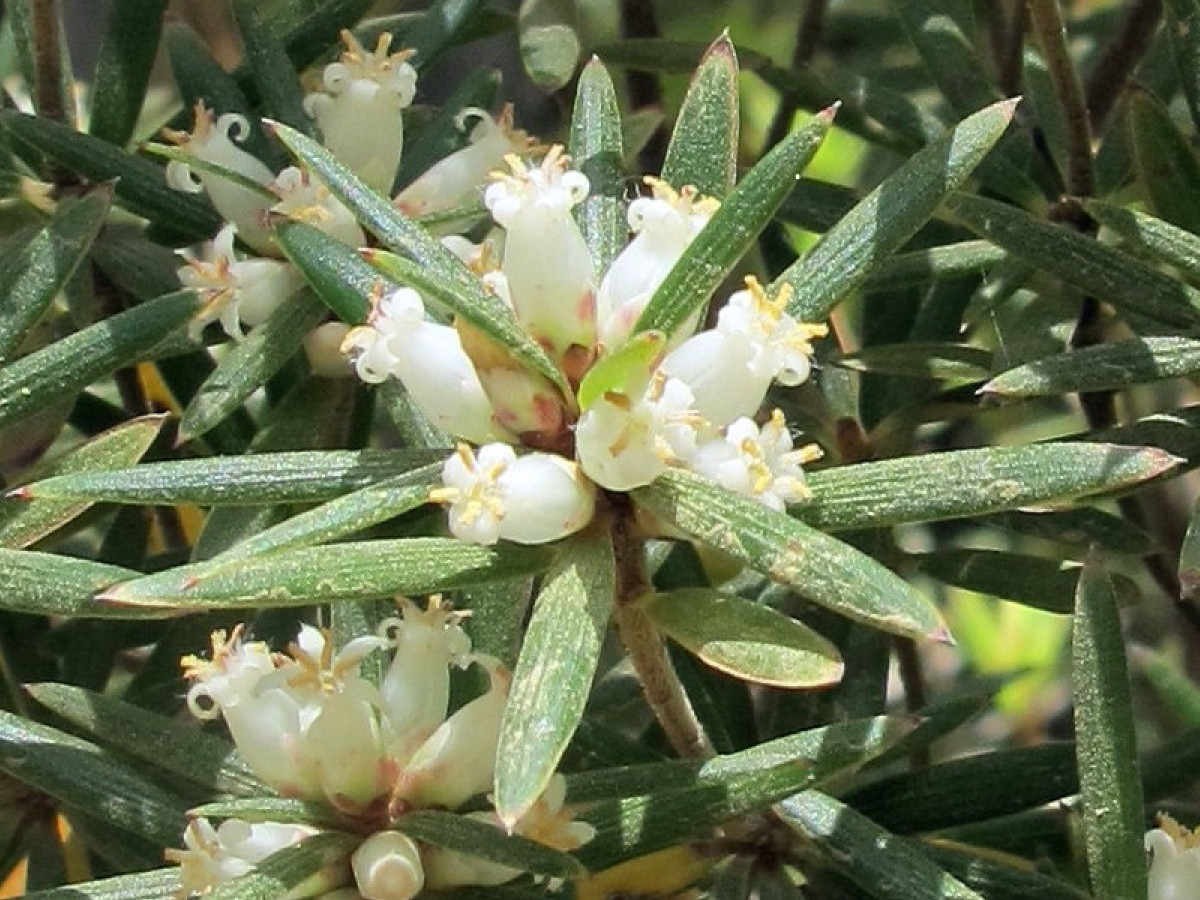Endemic flora A-C
Looking at the photographs To view the photographs, click on the species image to enlarge it,
then use the side arrows to page through images of the flowers, buds, fruit, leaves, foliage and plant(s) in the wild etc.
Viewing the meaning of botanical words To view the meaning of botanical words, hold the cursor on the blue word and the meaning will appear in a text box. On phones, turn to landscape to view all.
Based on Debenham C’s, The Language of Botany, A Publication of The Society for Growing Australian Plants, Chipping Norton NSW, c.1962.
Acacia axillaris
Botanical Name: Acacia axillaris (E)
Commonly Called: Midlands wattle
Botanical Family: Mimosaceae
Grows: This prickly shrub grows 3 to 4m high by 2 to 4m wide.
Foliage: The foliage is dark green phyllodes up to 5cm long, alternate, rigid with a prominent central vein and tapering to a sharp point.
Flora: The flowers are clusters of 3 to 4 stalkless, roundish buds, opening to cream/yellow balls.
Flowering Season: The flowers form in autumn to winter and open in late spring to early summer.
Fruit: The fruit of this Acacia are small 3 to 4cm long flat pods, with constrictions between the seeds.
How and where it grows: This rare species grows in a few places near some rivers in the Midlands and the north east.
Where found: The major population is found along the Elizabeth River; other occurances are found on the banks of the Clyde, Prosser and St Pauls Rivers; Glenmay Creek; Royal George; Lake Leake Road; Scrubby Den and between Big Den and Little Den along Lake River; Dawson Road Crossing on the Broad River; and Boomer Tier.
Other notes: This species is distinguished by its location in the wild. It may be confused with Acacia riceana but that species has clusters of phyllodes and rod shaped lemon/yellow flowers, or Acacia derwentiana, but that species has loose spikes of flowers and weeping habit. Propagation is best by hot water treated seed, then plants require moist soil in full sun to part shade.
Acacia derwentiana
Botanical Name: Acacia derwentiana (E)
Commonly Called: Derwent wattle
Botanical Family: Mimosaceae
Grows: This beautiful, bushy, weeping tree grows 1 to 3m high by 2 to 3m wide.
Foliage: The foliage is phyllodes 2 to 4cm long, usually alternate, sharply pointed and slightly curved.
Flora: The oval buds open into loose, pale yellow spikes
Flowering Season: The flowers appear from late spring to early summer.
Fruit: The fruit of this Acacia are 3 to 4cm long narrow pods, which are constricted between the seeds.
How and where it grows: On the banks of the Derwent River and its lower tributaries, and the banks of the Carlton and Prosser Rivers in south east Tasmania.
Where found: On the bank of the Derwent River beside the Glenora Road, 2km south from Plenty, downstream of the old railway bridge at the cascades; at the confluence of the Derwent and Broad Rivers via Dawson Road, Ouse; on the bank of the Tyenna River, beside the Gordon River Road, west of the Lake Fenton pipeline, Westerway; along the Carlton River at and upstream from the bridge on the Kellevie Road, Kellevie.
Other notes: This species is distinguished by its weeping habit and its location in the wild. It may be confused with Acacia riceana but that species has clusters of phyllodes, or Acacia axillaris, but that species has ball flowers.
Acacia mucronata subsp. dependens
Botanical Name: Acacia mucronata subsp. dependens E
Commonly Called: Blunt caterpillar wattle
Botanical Family: FABACEAE subfamily MIMOSOIDEAE genus ACACIA
Grows: This subspecies grows as a tall shrub or slender tree up to 10m high.
Foliage: The oblanceolate phyllodes with 5 to 7 longitudinal veins are 4 to 5cm long by 3 to 5mm wide and have very blunt apex with an obvious mucro.
Flowers: The loose axillary cream/yellow flower spikes are shorter than the phyllodes.
Flowering Season: The flowers appear in late winter and can continue through to late spring.
Fruit: The straight, narrow-linear pods with slightly convex valves are 6 to 14cm long, have slightly thickened wavy edges and are scarcely constricted between the seeds.
Habitat/distribution: This endemic species is locally frequent, especially in the north-west.
Where found: Places where it may easily be seen are Glover Bluff, South West; Tyndall Range, West Coast and Waratah Road, Savage River. it is also found on Cape Barren, Bruny, Flinders, King, Maria, Robbins, Sea Lion and Three Hummock Islands; many locations down the central highlands, the west and east coast hinterlands, and other places in Tasmania.
Other notes: This quick growing, hardy, tall shrub or small tree is suitable for screening, in a shelter belt or for a hedge. Propagation is by hot water treated seed. This species is one of the two endemic subspecies of Acacia mucronata in Tasmania. Acacia mucronata subsp. longifolia is also found in Victoria, so it is described in the “Spring A-C” page of this website.
Acacia mucronata subsp. mucronata
Botanical Name: Acacia mucronata subsp. mucronata (E)
Commonly Called: Erect caterpillar wattle
Botanical Family: FABACEAE subfamily MIMOSOIDEAE genus ACACIA
Grows: This subspecies usually grows 2 to 5m high by 2 to 5 wide in low altitude locations and is a dwarf bush at higher altitudes.
Foliage: The linear or narrow oblanceolate, leathery phyllodes are usually about 5 to 6cm long by 3 to 5mm wide with a blunt or mucronate apex. They have 3 to 5 prominent longitudinal veins and faint lateral reticulations. These reticulations are more prominent in montane habitats where the phyllodes are only about 2cm long.
Flowers: The loose axillary cream/yellow flower spikes are shorter than the phyllodes.
Flowering Season: The flowers appear in late winter and can continue through to late spring.
Fruit: The straight, narrow-linear pods with slightly convex valves are 6 to 14cm long, have slightly thickened wavy edges and are scarcely constricted between the seeds.
Habitat/distribution: This endemic species is locally frequent, especially in the north-west.
Where found: Places where it may easily be seen are Glover Bluff, South West; Tyndall Range, West Coast and Waratah Road, Savage River. it is also found on Cape Barren, Bruny, Flinders, King, Maria, Robbins, Sea Lion and Three Hummock Islands; many locations down the central highlands, the west and east coast hinterlands, and other places in Tasmania.
Other notes: This quick growing, hardy, tall shrub or small tree is suitable for screening, in a shelter belt or for a hedge. It was a pioneer on eroded hills near Queenstown. Propagation is by hot water treated seed. This species is one of the two endemic subspecies of Acacia mucronata in Tasmania. Acacia mucronata subsp. longifolia is also found in Victoria, so it is described in the “Spring A-C” page of this website.
Acacia pataczekii
Botanical Name: Acacia pataczekii (E)
Commonly Called: Wallys wattle
Grows: In the north-east highlands this species grows as an upright spreading shrub or tree 3 to 6 (up to 9m) high by 2 to 5m wide. In the south east it grows as a small open shrub, 0.5 to 1.5m high by 0.5 to 1m wide.
Foliage: The young branches are angular and when growing in the sun can colour to reddish brown. When they mature, the branches and their bark become glaucous. The grey-green to bluish glaucous phyllodes are 2 to 6cm long by 8 to 20mm wide, alternate and variable in shape from narrowly oblong-elliptic to oblanceolate or obovate. The phyllode edges and the midrib are prominently thickened and an obvious small oval gland forms 2 to 10mm from the stem on the upper edge. The phyllodes edges curve and taper to a mucro tip. On the younger stems, ridges form down the stems from the bases of the phyllodes, and when the phyllodes drop dark purple/brown scars remain on the stems.
Flora: The 5 to 15 pale to bright yellow globular flowers grow on short stems from the tips of the prominent zigs and zags of the raceme’s rachis. The zig-zag rachis is very obvious when the flowerheads and their stems drop off the tips. When bare, the rachis can be persistent for several months.
Flowering Season: The buds appear in autumn and the flowers open from mid winter to mid spring. The flowers are often attacked by insects which cause 1 to 1.5cm diameter galls to form. These mature to reddish colour and fall off many months later.
Fruit: The fruit of this species are rarely found, possibly due to the gall insect. When found they are narrow oblong 2.5 to 4.5cm long by 7 to 11mm wide. The flat purple/brown pods hold 3 to 6 brown, flat seed. In some years a masting event may occur and many trees of this species all produce many fruit and some viable seed. When masting occurs fewer galls have ben observed. Masting occurred in December 2024 in Hobart.
How and where it grows: In the north east this species grows as a glaucous tall shrub or small tree in moist gullies and flats, mountain summits, slopes and plateau scarps in low woodland to tall open, dry, wet and mixed Eucalyptus forests. In the southern midlands it grows as a small, open, glaucous shrub on a dry open lightly timbered rocky hillside. In both locations the plants spread by rhizomatous suckers, possibly as an evolutionary survival defence to the gall infestations.
Where found: In the north east the tall shrub and tree form are found near Ben Nevis and Roses Tier along Upper Blessington and Telopea Roads; Ben Lomond Conservation Area; Tower Hill near Fingal; between Mathinna and Tower Hill; east of Gibsons Marsh and west north west Fehres Marsh, Fingal. In the south east the small open shrub is found in a small area in the Gravelly Ridge Conservation Area, about 10km east of Campania.
Other notes: This species is listed as “rare” under the Threatened Species Protection Act 1995 under Tasmanian legislation. Due to its suckering habit, it is not commonly grown in home or display gardens. It can be distinguished by its grey-green to bluish glaucous phyllodes with the prominent gland on the upper edge, the dark purple/brown scars left after phyllode fall and the flower racemes with prominent zig-zag rachis. It has been confused with Acacia myrtifolia but that species has prominent red stems and bright green phyllodes, or Acacia melanoxylon, but that species has larger, longer, grey/green phyllodes which taper to a point at both ends and larger ball flowers.
Acacia riceana
Botanical Name: Acacia riceana (E)
Commonly Called: Arching wattle
Grows: This species grows as an upright spreading shrub or tree, 3 to 6m high by 2 to 4m wide with pendulous branches.
Foliage: The scattered or almost whorled, often semi-erect and clustered, dark green phyllodes are 1.2 to 4.5cm long by 1.5 to 3.0mm wide. They are narrow linear and the apex tapers to a sharp point. They usually have one prominent central vein but also sometimes have fainter, prominent, lateral veins.
Flora: The buds with 3 or 4 sepals and petals open to profuse, loose, lemon/yellow flower spikes. They grow from the phyllode axils on approximately 3cm long stems which are usually longer than the phyllodes.
Flowering Season: The buds appear in autumn and the flowers open from late winter through spring.
Fruit: The fruit of this species are narrow, curved, 4 to 6cm long, leathery pods which are constricted between the seeds.
How and where it grows: This species grows locally common in shaded, damp gullies of southern Tasmania. It is also found in the open in some drier and higher places.
Where found: Many locations including: kunanyi/Wellington Park; South West and Tasman National Parks; along the Derwent, Huon and Northwest Bay Rivers; Bruny Island; and the Wielangta and Sandspit Forest Reserves area.
Other notes: Acacia riceana grows in full sun to part shade, enduring both moist and short dry periods and in clay to sandy soils. Propagation from hot water treated seed is reliable after seeds have been kept for a month or more after collection. Special versions may be propagated from semi-hard wood cuttings. The arching habit, clustered phyllodes and profuse flowers of Acacia riceana differentiate it from Acacia axillaris.
Agastachys odorata
Botanical Name: Agastachys odorata (E)
Commonly Called: Fragrant candlebush
Botanical Family: Proteaceae
Grows: 1-3m H x 0.5m-1m W
Foliage: Leaves 4-5cm long, green, round tipped with smooth edges, narrow oblong to oblanceolate and crowded toward the end of the stems.
Flora: Flowers cream/white, dense, erect spikes at the end of the branches in clusters, usually strongly perfumed.
Flowering Season: The beautiful flowers are seen in summer.
Fruit: A hard to find winged nut.
How and where it grows: The west and south-west of Tasmania in areas of high rainfall, often on poor soils, found in exposed positions and sheltered gullies.
Where found: South West and Franklin-Gordon Wild Rivers National Parks; Adamsons Peak Track at edge of plateau; Hartz Mountain Road eastern side below Waratah Lookout picnic shelter.
Other notes: Cuttings strike easily with strong white roots. However, it is best grown in a pot because it is hard to establish in home gardens and hard to maintain. This species is distinguished by the erect growth, leaves clustered at the end of the stems and clusters of flowers spikes at the end of the branches.
Allocasuarina crassa
Botanical Name: Allocasuarina crassa (E)
Commonly Called: Cape Pillar sheoak
Botanical Family: Casuarinaceae
Grows: At Cape Pillar this endemic, dioecious or monoecious species is severely wind-pruned so grows as a small, open 1 to 2m, or up to 4m high shrub. In sheltered home gardens in Hobart and Ferntree areas it can grow as a large, open, spreading bush more than 5m high by 6m wide.
Foliage: The spreading or ascending branchlets 8 to 17cm long by 1.0 to 2.5mm diameter are often tightly clustered. They are smooth with densely or sparsely pubescent furrows and bluntly angular to rounded ridges. The 0.8 to 1.5mm long, 7 to 10 leaf-teeth are appressed to slightly spreading.
Flora: The 1.0 to 3.6mm long male flower spikes in 3.5 to 4 whorls/cm with 0.8 to 1.3mm long anthers are deciduous when young. The female globular or ovoid inflorescences are sessile or on short axillary branches. Their whorls of crimson flowers are each subtended by a bract (a modified leaf-tooth) and by a lateral pair of minute bracteoles. These become much enlarged and more or less woody in fruit.
Flowering Season: The flowers appear in spring and continue through autumn.
Fruit: The 1.5 to 3.5cm long by 1.2 to 2.0cm diameter cones grow on 3 up to 8mm long peduncles. Their bracteoles are obtuse to truncate and the pyramidal to triangular protuberances are shorter than the body of the bracteoles. The 5 to 8mm long samara are black.
How and where it grows: Restricted to the Cape Pillar area, growing singularly among dolerite rocks near or on exposed coastal cliffs.
Where found: This species is only found naturally on Cape Pillar in Tasman National Park and Tasman Island.
Other notes: In private or public gardens it prefers well-drained soils in full sun and can withstand frosts and long periods of dry conditions. The plants with female flowers create an excellent display for many months. It is easily propagated from well-dried seed. It is distinguished from other Sheoaks by the coarse grooved appearance of the branchlets, stems and the trunk with their striking terminal curve of the leaf-teeth.
Allocasuarina monilifera
Botanical Name: Allocasuarina monilifera (E)
Commonly Called: Necklace sheoak
Botanical Family: Casuarinaceae
Grows: This erect shrub may be dioecious or monoecious and grows typically 1 to 3m but possibly up to 5m high by about 1 to 4m wide.
Foliage: The green to glaucous, drooping or erect 5 to 18cm long branchlets are variable in size from robust to slender but smooth with convex to angular ridges and the very narrow furrows have hairs which are not seen at the surface. These branchlets are segregated into 3.9 to 9.0mm long sections called articles. The triangular to narrow triangular leaf-teeth at the junctions between the articles are in whorls of usually 6 to 9.
Flora: The female globular or ovoid inflorescences are sessile or on short axillary branches. Their whorls of red flowers are each subtended by a bract (a modified leaf-tooth) and by a lateral pair of minute bracteoles. These become much enlarged and more or less woody in fruit. The 1.0 to 4.5cm long male flower spikes on 2 to 10mm long peduncles have 4 to 8 whorls/cm of 0.7 to 1.2mm diameter anthers.
Flowering Season: Flowers appear throughout the year.
Fruit: The 1.0 to 3.5 and up to 4cm long cones are ellipsoid or cylindrical and grow throughout the year. The cone-valves are bluntly pointed or rounded and the unequally three-faced protrubing dorsal surfaces become curved when dry. The 3.5 to 7mm long samaras with only one seed are usually black or occassionally bright orange.
How and where it grows: Widespread throughout the State except for the Midlands, and Bass Strait islands, from sea level to 1,100m altitude. Tolerates a wide range of soils from sand to clay, coastal heaths to subalpine scrub.
Where found: It has been seen and recorded in Baker Beach – Briggs Regional, Bluff River Gorge, Bridport Wildflower, Echo Sugarloaf, Knocklofty, Peter Murrell, Risdon Brook and Mount Direction Conservation area, the Tarkine and Winifred Curtis Reserves; Douglas Apsley, Freycinet including Schouten Island and Tasman National Park (NP)s; many Bass Strait islands and possibly Wilsons Promontory; Tasmanian Bushland Gardens and Tasmanian Native Garden; and many other locations around Tasmania and in many local parks, reserves and private gardens.
Other notes: This robust, easily grown from seed species prefers well-drained soils in full sun. It can withstand long periods of dry weather and is frost tolerant. The female plant with its red flowers is very attractive when in flower. It is distinguished from other Allocasuarina species by the stems and trunk having coarse grooves and by the very noticeable curve on the apex of the leaf-teeth on the branchlets. All parts of the plant is more coarse than other Allocasuarina species.
Anodopetalum biglandulosum
Botanical Name: Anodopetalum biglandulosum (E)
Commonly Called: Horizontal
Botanical Family: Cunoniaceae
Grows: 2-15m H x 2-15m W
Foliage: The shiny green, elliptical leaves are alternate on the mid-green stems. The leaf edges have glands on the tips of the smooth serrations. The slender branches bend over when they get too tall, to become horizontal and new branches grow vertically up from them, then they also bend over when they also get too tall. If undisturbed, eventually a pile of branches several metres high can form and present an impenetrable barrier.
Flora: The small flowers have four triangular cream to pale green lightly stripped sepals then four smaller, narrow petals arranged alternately around a green carpel (female flower fertilisation part). The flowers grow in the leaf axils on very short stems.
Flowering Season: Spring
Fruit: The fruit of this species is a fleshy drupe with a stone enclosing one seed inside.
How and where it grows: Locally common in wet forests of the north-west, west and south.
Where found: Hartz Mountain National Park (NP), especially along the Old Hartz Track between Kermandie Falls and the Hartz NP carpark; throughout the South West and the Franklin Gordon Wild Rivers NP; Cradle Mountain Lake St Clair NP.
Other notes: This species may be grown successfully in home gardens with plenty of space, constantly moist, well-drained and mulched soils. It may be grown from semi-hardwood cuttings. It can be a problem for bushwalkers on old unmaintained tracks as it is difficult to walk over the deep bed of horizontal branches.
Anopterus glandulosus
Botanical Name: Anopterus glandulosus (E)
Commonly Called: Tasmanian laurel
Botanical Family: Escalloniaceae
Grows: 2-4m H x 2-3m W
Foliage: The 7 to 17cm long by 2 to 4cm wide, bluntly serrated, large glossy leaves have a gland at the tip of each serration.
Flora: The white to pink flowers in long terminal clusters have 6 overlapping petals that form a bell shape and feature prominent central, green carpels.
Flowering Season: The flowers appear in Spring and continue through into summer
Fruit: The fruit of this species are brown capsules containing many small winged seeds.
How and where it grows: Moist understorey in rainforest. Widespread in high rainfall areas throughout the South Western half of the State, sea level to mountain.
Where found: Hartz National Park (NP), especially along the old Hartz Track; Mt Field NP, easily seen along the Lake Dobson Road and mountain tracks; Tasman NP, McGregor Peak Track and other rain forest areas; and Cradle Mountain Lake St Clair NP along the Overland Track and in all rainforest areas.
Other notes: This species makes and excellent container plant for moist shady to sunny areas and it is also a lovely garden plant for moist, mulched, well-drained soils. The light pink flowering form can only be reliably reproduced from semi-hard wood cuttings but the species may be grown from fresh seed which may be slow to germinate. The seed raising mix and seedlings should be kept constantly moist. It responds well to pruning to size and shape.
Aristotelia peduncularis
Botanical Name: Aristotelia peduncularis (E)
Commonly Called: Heartberry
Botanical Family: Elaeocarpaceae
Grows: This species is easily recognised when in fruit and grows as a small open bush up to 4m high by 0.5 by 1m wide.
Foliage: The lanceolate to broadly ovate glabrous leaves, with stems 0.5 to 10cm long, grow 1.5 to 8cm long by typically 8 to 15mm but may be as narrow as 5mm, or as wide as 20mm wide. They are very variable in shape. The stem end is usually rounded and the tip is acute or acuminate. The leaf edges are serrated, sometimes deeply pinnately divided into 3 to 4 pairs of narrow serrated lobes. The leaf uppersides are often shiny dark green, while the undersides are paler green.
Flora: The flowers hang by slender stalks, up to 40mm long, from the leaf axils, singly or two or three together. They are white, bell shaped, with four or five deeply lobed petals which may be pink/purple marked to some extent inside.
Flowering Season: The spring time flowers are seen from October to December.
Fruiting body: The heart shaped, fleshy berry fruit appear in summer from January to March and are white or light pink, red to dark purple/black. It is suggested that they may change from white to light pink Through to deep red with age.
How and where it grows: Widespread straggly, woody bush, locally common in shady moist forests. It may be hard to recognise due to its sparse foliage but its fruit is easily recognised.
Where found: Hartz, Cradle Mountain Lake St Clair, South West and Tasman National Parks; Montezuma Falls Track; Pipeline, pinnacle and North South Tracks in kunanyi/Mount Wellington; Bruny Island south.
Other notes: This species may be propagated from semi-hardened cuttings. It requires moist soil in part shade and should be pruned for bushy growth after the distinctive heart-shaped fruit falls or is eaten.
Astelia alpina var. alpina
Botanical Name: Astelia alpina var. alpina (E)
Commonly Called: Pineapple grass
Botanical Family: Liliaceae
Grows: This dioecious species is easily recognised due to its broad, long, pointed leaves in dense, spreading clumps called mats.
Foliage: The hairy at base and sheathing, 6 to 30cm long by 2 to 3cm wide leaves taper to a point, and are stiff with recurved edges. Their silvery lower surfaces are covered with fine white hairs and their green upper surfaces have a few hairs.
Flora: The small flowers grow with up to 30 female flowers on 4 to 6mm long greenish yellow perianths in a 1 to 2.5cm long panicle. They are on a 2 to 8cm long scape, hidden deep within the leaves. The exserted 30 to 80mm long male panicles on 3 to 12cm long scapes have 10 to 60 flowers with 2 to 4mm long greenish yellow perianths.
Flowering Season: The flowers are seen from December through February.
Fruiting body: The elongated, red, edible berry fruit, which appear deep within the female clumps from December to March, are 6 to 10mm long by 3 to 4mm diameter, with a locule containing 4 to 8, about 1.8mm long, seeds.
How and where it grows: Widespread leafy clumps, often in large swathes or mats, locally common in bogs and wet sites in alpine and subalpine areas. It is easy to recognise due to its leaves being similar to pineapple plants, and its bright red fruit assist with recognition.
Where found: Ben Lomond, Hartz, Cradle Mountain Lake St Clair, Mt, Field and South West National Parks; Mount Barrow, Mt. Read State Reserves; kunanyi/Mt. Wellington, and other alpine and sub alpine areas.
Other notes: This sub species is endemic to Tasmania, while Astelia alpina var. nova hollandiae grow in NSW and Vic. It may be propagated from seed or by division. It can be grown in full sun in a bog garden with regular water flow.
Asterotrichion discolor
Botanical Name: Asterotrichion discolor (E) (E)
Commonly Called: Tasmanian currajong
Botanical Family: Malvaceae
Grows: This usually dioecious tree grows 3 to 8m high by 2 to 4m wide.
Foliage: The leaves are variable in size, alternate, upper surface dull green with much-divided veins, lower surface covered densely with star shaped hairs and the edges of leaves bluntly serrated.
Flora: The flowers are small with 5 white petals. There are usually male and female on separate plants, perfumed and prolific on axillary stems.
Flowering Season: The flowers appear from mid to late autumn and continue through to winter.
Fruit: The fruit is a 2 celled indehiscent capsule.
How and where it grows: This species has limited distribution in damp eucalyptus gullies in the south-east, including Bruny Island and Tasman Peninsula.
Where found: Bluff River Gorge; Kellevie Road, Nugent; Carlton River upstream from Kellevie Road, Kellevie; Kingston Wetlands and kunanyi/Mt Wellington.
Other notes: A very attractive garden specimen with masses of sweetly perfumed flowers in autumn. It requires moist, well-drained soil with part shade. It may be propagated from seed or cuttings. The fibrous nature of the bark may make this plant useful for paper-making.
Athrotaxis cupressoides
Botanical Name: Athrotaxis cupressoides (E)
Commonly Called: Pencil pine
Botanical Family: Cupressaceae
Grows: This conical form tree grows 8 to 20m high by 2 to 6m wide.
Foliage: The olive green, blunt tipped, overlapping leaflets about 5mm long are wrapped around the many branches which spread from the tapered trunk. The light grey fibrous bark has furrows.
Flora: The very small terminal male cones or stromboli produce pollen which may appear in a cloud when the branch is shaken. The tiny female immature cones are often on separate branches.
Flowering Season: Inconspicuous immature cones appear in spring.
Fruit: The spiky, spherical, mature cones grow up to 1.5cm diameter and open after some months or even years to release narrow winged seeds. As with other Tasmanian conifers, this species has masting events. In Cradle Mountain, most recently in 2009.
How and where it grows: High altitude areas, 700-1,200m, of the western and central mountains, in damp depressions or along stream and lake edges forming dense stands in some areas.
Where found: Cradle Mountain Lake St Clair, Mount Field, Franklin-Gordon Wild Rivers, Southwest and Walls of Jerusalem National Parks.
Other notes: This slow growing conifer, about 2m in 10 years, may best be grown in a large pot and makes a nice Christmas tree. It requires moist well-drained soil in full or part sun. It may be propagated from semi-hardwood tip cuttings or fresh seed.
The densely overlapping, stem clasping leaves of this ‘pencil-shaped’ or conical tree found growing around Central Highland tarns aid in its recognition. It is suggested that some trees of this species in the wild may be over 1,000 years old.
Athrotaxis selaginoides
Botanical Name: Athrotaxis selaginoides (E)
Commonly Called: King Billy pine
Botanical Family: Cupressaceae
Grows: 15-40m H x 2-5m W
Foliage: The bright green, 6 to 12mm long leaves are broader in the middle, tapered at both ends with a sharp point on the tip, concave on the upper side, thick and loosely overlap.
Flora: The immature cones on the tips of the branchlets are hard to see.
Flowering Season: Spring
Fruit: The bright green mature cones have pointed scales which are concave on the inner face and taper at the base. The cones are roughly spherical to about 2cm diameter. As with other Tasmanian conifers, this species has masting events. In Mount Field, most recently in 2009.
How and where it grows: Moist slopes of high rainfall area in the western and southern mountains to 1,200m, often in rainforest, sometimes as pure stands, and sometimes extending to alpine zones.
Where found: Cradle Mountain Lake St Clair, Mount Field, Franklin-Gordon Wild Rivers, Southwest and Walls of Jerusalem National Parks. Around Macquarie Harbour and other South Western locations.
Other notes: This magnificent conifer species is readily identified by its large conical shape and bright green overlapping leaves. Its light weight timber is treasured for dinghy building, picture frames and furniture. It used to be used for refinery reactor tank tops. Sadly, when burnt in a bushfire it dies and fails to regenerate.
Bedfordia linearis
Botanical Name: Bedfordia linearis
Commonly Called: Slender blanketleaf
Botanical Family: Asteraceae
Grows: This bushy shrub or small slender tree grows 2 to 3m high with many branched stems, each topped by foliage and flower clusters.
Foliage: The young branches, the leaf undersides and the involucres are white tomentose with stellate hairs. The alternate narrow-linear, 1.5 to 9.0cm long leaves with the base narrowed have a very short or scarcely any petiole. The apex is blunt and the edges are entire and slightly revolute. The upper surface is glabrous with veins less conspicuous than Bedfordia salicina.
Flowers: The flower-heads are 1 or 2 together or more in the leaf axils. They are similar to but sometimes slightly larger than those of Bedfordia salicina.
Flowering Season: The flowers appear in summer.
Fruit: The fruit are cylindrical achenes about 2.5mm long, striate and glabrous. They usually have a pappus to aid wind dispersal.
Habitat/distribution: This species is common and widespread in shady moist areas and wet forests up to 1000m, especially along the west coast. It is also indigenous to SA, Vic and NSW.
Where found:kunanyi/Mt. Wellington; Echo Sugarloaf; Knocklofty and Peter Murrell Reserves; the Tarkine; and Tasman National Park.
Other notes: This scrambling spreading moist area bush is very useful for erosion control. It grows best in part sun; moist but well-drained soil. It may be propagated easily from cuttings which enables special forms to be cloned.
Three subspecies occur, Bedfordia linearis subsp. linearis Slender blanketleaf, Bedfordia linearis subsp. oblongifolia var. curvifolia Curved blanketleaf, and Bedfordia linearis subsp. oblongifolia var. oblongifolia Blunt blanketleaf.
Bedfordia salicina
Botanical Name: Bedfordia salicina (E)
Commonly Called: Tasmanian blanketleaf
Botanical Family: Asteraceae
Grows: 2-5m H x 2-3m W
Foliage: The elliptical, alternate, undulate leaves are dark green on the upper side, silver hairy underside and are from 6 to 10cm long.
Flora: The 5 to 25 or more, yellow flower-heads grow in dense axillary panicles which are shorter than the leaves. The cylindrical, 5 to 6mm long involucre has about 8, wooly-white, linear, bluntly pointed phyllaries. The tubular, yellow, hermaphrodite florets are slightly longer than the involucre and the anthers are bluntly pointed at the base and have a small terminal appendage.
Flowering Season: Flowers present a beautiful sight in spring
Fruit: The fruit are cylindrical achenes about 2.5mm long, striate and glabrous. They usually have a pappus to aid wind dispersal.
How and where it grows: These plants are found in wet gullies and sclerophyll forests at low altitudes, and are common and widespread in moist areas.
Where found: Glover Track, Knocklofty Reserve; Lenah Valley Track, Wellington Park; Fortescue Bay, Tasman NP; Lyell Highway, Tarraleah; Howells Bluff, Lake Rowallan.
Other notes: This shrub or small tree is best grown in constantly moist soil and full to part shade. Propagation is best from seed, because cuttings can be difficult possibly due to the hairy stems on the younger growth.
The bright yellow, daisy-like flowers and the surrounding white backed leaves make this species easily recognised. This species is the reason the diverse understorey has disappeared from the slopes of kunanyi/Mount Wellington since the 1967 bushfires causing a major change in the small bird populations in that area.
It ‘blankets’ out the sun and smaller plants have not re-established. It may be dying off, due to old age, thus opening the canopy and allowing the understorey to re-establish.
Bellendena montana
Botanical Name: Bellendena montana (E)
Commonly Called: Mountain rocket
Botanical Family: Proteaceae
Grows: This small rounded shrub grows from 0.5 to 1m high by 1 to 2m wide.
Foliage: The green, leathery leaves, 1 to 4cm long, are egg or wedge shaped with the broadest part toward the tip which has 3 lobes. They are arranged alternately up the reddish stems.
Flora: The clusters of white, 1.5 to 2cm long, flower buds on top of short stems are usually longer than the leaves and are shaped like miniature baseball clubs, often dark pink on the broader tip. The petals fold out at 90 degree spacing from the top 1/4 to 1/3 of the flower stem’s length. The white flat stamens appear to fold out with the petals and are similar in shape, while the cylindrical stigma, style and ovary are reddish.
Flowering Season: Flowers appear in summer.
Fruit: The various shades of red through to yellow, flattish, pendlous fruit are papery sacs containing a small seed.
How and where it grows: It is found on moist, moderately well drained mountain woodland and grasslands and is widespread above 600m.
Where found: Wellington Park; Hartz, Mt Field, Cradle Mt Lake St Clair and Ben Lomond National Parks.
Other notes: Requiring a cool moist site, this slow-growing small shrub attracts one’s attention with its complex flowers and bright coloured fruit clusters, the red ones reminiscent of the flames from a rocket, hence the common name. While propagation from seed or cuttings can be difficult, once established, the species can be successfully grown as a pot plant.
Billardiera longiflora
Botanical Name: Billardiera longiflora (E)
Commonly Called: Purple appleberry
Botanical Family: Pittosporaceae
Grows: This endemic twining vine grows to 3m over shrubs with strong, shining brown, smooth, hairless stems.
Foliage: This vine’s leaves are dark green on the upper side and lighter underneath, 2 to 3cm long and tapering at both ends, sharper at the roundish tip and broader at the stem end, ocasionally sparsely hairy along the slightly curved downward edges.
Flora: The pendulous flowers of this climber are solitary in the upper leaf axils on 10 to 15mm long stems. Short shiny, purple brown sepals surround the base of the greenish yellow, loosely cohering petals which form a narrow tube, 10 to 20mm long, slightly bulging in the centre, sometimes slightly flaring at the tips and nearly hide the stamens and carpels. In ageing flowers, the petals separate and discolour to sometimes blotchy, purplish blue.
Flowering Season: The flowers appear through spring and summer.
Fruit: The distinctive globular/oblong, blue, rarely white fruit are soft and plump berries, 17 to 25mm long, and tending to become squarish when very large. They appear through summer and autumn, and contain many 2mm long seeds surrounded by soft pulp.
How and where it grows: Usually found in wet sclerophyll forests, this climber is common in southern eastern Tasmania to 900m level.
Where found: Organ Pipes, Lenah Valley, Old Hobartians and Pipeline Tracks and many other places in Wellington Park; Waterworks Reserve, and other southern moist Reserves and southern National Parks; Kellevie area.
Other notes: A very rewarding climber for any moist garden. Propagation best but unreliable from seed. Germination may be improved by stratifying detergent washed seed at 40 degrees C. for 6 to 8 weeks then waiting up to 2 years for the seed to sprout.
Revision of the genus has seperated Billardiera longiflora and Billardiera macrantha. The latter species is more widespread in Tasmania and is also found in NSW, ACT and Vic. It has longer and more widely spreading petals, firmer fruit, climbs up to 8m high and can form a leafy canopy over supporting understorey.
Blandfordia punicea
Botanical Name: Blandfordia punicea (E)
Commonly Called: Christmas bells
Botanical Family: Liliaceae
Grows: This beautiful lily grows in a clump from 50 to 100cm high.
Foliage: The tough green leaves are sometimes tinged reddish brown and strap-like up to 100cm long, with finely serrated edges.
Flora: The tubular flowers with red to orange petals are narrower at the stem end, flared at their tips, and grow in racemes at the top of stems up to 1m high.
Flowering Season: The flowers appear in late spring and may still be seen in early summer.
Fruiting body: Long triangular pods containing many seeds that ripen in autumn.
How and where it grows: A colourful lily found as an understorey species of rocky slopes from sea level to subalpine in south, north-west and west.
Where found: Bruny Island; Cradle Mountain, Overland Track at Marions Lookout, “Lake Rodway Track near the Lake Hanson saddle and western side of the Dove Lake Circuit in the quartz scree”1; Zeehan at the old smelter site; Lake Burbury, Queenstown side; Randalls Bay Quarry Reserve.
Other notes: May be recognised by its fine leaf edge serrations and the tall clusters of red/orange bell-shaped flowers, this beautiful species may be difficult to maintain. It requires well-drained moist soil in full sun and may be grown in an earthenware pot with a saucer to maintain moist soil. It propagates easily from seed but is slow to flower, maybe up to 7 years.
Reference: 1. Burns. D 2012, Exploring the FLORA of Cradle Mountain DAY WALK AREAS: PLANT IDENTIKIT, Dick Burns p68.
Boronia citriodora
Botanical Name: Boronia citriodora (E)
Commonly Called: Central lemon boronia
Botanical Family: Rutaceae
Grows: This small, aromatic, woody shrub grows 0.5 to 1m high by 0.5 to 1.5m wide.
Foliage: The leathery, crowded, pinnate leaves (multiple leaflets arranged on both sides of the central rib), lime green when young, age to dark green and are 7 to 15mm long with 1 to 7 leaflets, 4 to 10mm long by 0.5 to 2.5mm wide.
Flora: The flowers with four petals, grow on the stem tips or from the leaf axils, in clusters of 1 to 3 per cluster, and are white to pink with buds that are often dark pink.
Flowering Season: The flowers are found through spring and summer.
Fruit: The fruit are small capsules with four cells.
How and where it grows: This lovely small plant often grows in swathes in moist, well drained subalpine and alpine heath from the Central Highlands to near Hobart, in the north-east, and down to sea-level in the south-west.
Where found: Wombat Moor, Mount Field National Park; Cradle Valley, Dove Lake and along the Overland Track on the way up to Crater Lake, Cradle Mountain National Park; Lyell Highway east of Derwent Bridge; Adamsfield and Timms Tracks, South West National Park; Tasmanian Arboretum and many other places; and, some home gardens with suitable conditions and soil.
Other notes: Strong lemon aroma when the leaves are crushed or handled helps identify this species. It may be propagated from cuttings, layering or seed and prefers to be grown in moist well drained soil in full sun.
B. citriodora subsp. citriodora, Central lemon boronia, is the most wide spread of the three subspecies,
B. citriodora subsp. paulwilsonii, Leggy lemon boronia, is mainly confined to the south west and grows up to 3m tall with 1 to 7 flowers per cluster,
B. citriodora subsp. orientalis, Mount Barrow lemon boronia, is only found in the Mount Barrow area, has very fine leaflets, only 1 to 2mm wide, and its flowers are solitary.
Boronia gunnii
Botanical Name: Boronia gunnii (E)
Commonly Called: River boronia (syn. Gunn’s or Cataract Gorge boronia)
Botanical Family: Rutaceae
Grows: An erect shrub 0.5 to 1.5m high by 0.5 to 1m wide with slightly glandular nodules along the branchlets.
Foliage: The pinnate leaves (multiple leaflets arranged on both sides of the central rib) have 5 to 9 leaflets, 12 to 32mm long by 16 to 50mm wide covered with glandular bristles.
Flora: The clusters of flowers on a short stem, 1.5 to 3mm long, are 1 to 7 pink or white flowers with 3.5 to 8.5mm long petals each with 5 to 9mm long stems in the leaf axils.
Flowering Season: The flowers appear in mid spring through to mid summer.
Fruit: The fruit is a hairless capsule appearing in late summer which dries and splits open to release a seed.
How and where it grows: A Tasmanian endemic species that is listed as vulnerable by the Threatened Species Committee. It grows in the rocky, fast flowing, flood prone areas along a few eastern rivers.
Where found: Apsley, St Pauls and Dukes Rivers in eastern Tasmania, possibly extinct from Cataract Gorge.
Other notes: The stems are very flexible and can be almost tied in a loose knot without breaking (verbal information from the Tasmanian Herbarium). Plants are usually found in open, rocky, river areas that may be regularly flooded. In a home or park garden it requires moist, well-drained, mulched soil in semi shade.
Callitris oblonga
Botanical Name: Callitris oblonga subsp. oblonga (E)
Commonly Called: South Esk pine
Botanical Family: Cupressaceae
Grows: This erect, compact bush or small tree grows 2 to 5m high by 1 to 2m wide.
Foliage: The green to bluish-green foliage is leaflets about 1mm long in whorls of 3 around the stems, which grow on branches and branchlets, persistent from the ground up, that angle slightly upward from horizontal.
Flora: The immature male cones are up to 3mm long and grow on the tips of some leaflets. The female cones are about 1mm long and grow singly, or several clustered together, on some branchlets.
Flowering Season: Immature cones appear in winter.
Fruit: The pear shaped mature cones have a small terminal protrusion on each of the three larger inner scales and also on the three smaller outer scales.
How and where it grows: This endemic Tasmanian subspecies is rare, occurring on the banks of the Swan, Apsley, South Esk and St Pauls Rivers. Two other subspecies occur in NSW.
Where found: Apsley River eastern bank at the corner of Coles Bay Road just over the bridge; Inverawe Native Gardens at Margate, Tasmanian Arboretum at Eugenana, Tasmanian Bushland Gardens near Buckland.
Other notes: An ideal container plant suitable for a Christmas tree, or as an attractive specimen garden plant or with other plants. This species is readily distinguished from Callitris rhomboidea by the shape of its cones, its bluish-green foliage and compact erect shape. It may be easily propagated from seed.
Cenarrhenes nitida
Botanical Name: Cenarrhenes nitida (E)
Commonly Called: Native plum
Botanical Family: Proteaceae
Grows: This open shrub/small tree grows 3 to 8m high and 3 to 6m wide. In some locations it can be found as a semi-prostrate shrub.
Foliage: The toothed edge, bright, shiny green leaves have an indented central yellow-green vein and are up to 15cm long, broad, with a round tip and tapered toward the short stem. Bruising the leaves may create a nauseating odour.
Flora: The little, white flowers cluster in spikes toward the ends of the plant’s stems. They have four petals that curve back towards the stem and are pointed at the tip and broad at the throat in which is a single pale green carpel and four stamens that are aligned with the petals.
Flowering Season: The flowers appear in summer.
Fruit: Green, small, cherry-sized, fleshy fruit ripen to deep purple in autumn.
How and where it grows: Often found in open forest or woodland, but preferring rainforest, it grows as an understorey shrub or open small tree from the north-west to the west and south-west from sea level to subalpine regions.
Where found: Cradle Mountain Lake St Clair, Hartz, Franklin-Gordon Wild Rivers, Mount Field and South West National Parks; specifically, Echo Point on Lake St Claire, Hartz Road near Waratah Lookout and many other places.
Other notes: The yellow/green central vein in the leaves, lack of glands on the tips of the leaf serrations and the deep purple fruit distinguish this species from Anopterus glandulosus.
It requires moist, well-drained, humus rich, well mulched soils and is slow growing. Propagation from seed is difficult but semi-hard wood cuttings strike well in mist.
Centropappus brunonis
Botanical Name: Centropappus brunonis (E)
Commonly Called: Tasmanian daisytree
Botanical Family: Asteraceae
Grows: This rare large bush or small tree with limited distribution grows 2 to 4m high by 1.5 to 3m wide. The leaf bases cause prominent and persistent scars on the branches when they fall. The broadly linear, entire, sessile, spreading leaves, 5 to 9cm long, are crowded near the ends of the branches. They are glabrous and somewhat coriaceous, glabrous but more or less sticky, aromatic when crushed and their apex is bluntly pointed.
Flora: Terminal, corymbose panicles form the inflorescences. The involucre are campanulate and calyculate and the about 8 in a row, ovate and more or less sticky, coriaceous phyllaries have scarious edges and a blunt fimbriate apex. The bracteoles are small and entire, while the ray florets have broad yellow spreading ligules about as long as the involucre. The disc-florets are longer than the involucre and twice as numerous as the ray florets.
Fruit: The fruit are glabrous achenes with rigid, prominently barbellate and at the ends almost plumose pappus-bristles.
How and where it grows: This endemic species is only found in limited areas on kunanyi/Mount Wellington and around Mount Dromedary between 600 and 800m altitude. It grows as an understorey shrub or open small tree.
Where found: The best locations to see this beautiful flowering tree is on the down hill side of the Pinnacle Road opposite the Chalet on kunanyi/Mount Wellington. There are other plants around the Chalet, about 100m down on the uphill side of the Pinnacle Road, also on the lower end of the Ice House Track and on the Wellington Falls Track. There are also plants up Myrtle Forest Creek, Collinsvale, on Mount Dromedary and around nearby Platform Peak.
Other notes: The large yellow flower clusters and sticky aromatic leaves on a pyramid shaped tree are the distinguishing features. It is an attractive garden tree in a cool area and may be propagated from fresh seed.
Correa lawrenceana var. lawrenceana
Botanical Name: Correa lawrenceana var lawrenceana (E)
Commonly Called: Mountain correa
Botanical Family: Rutaceae
Grows: In Tasmania this bushy shrub grows 1 to 4m high by 2 to 3m wide.
Foliage: The stems have tufts of soft wooly hairs. The leaves are tough and pliable or papery with stalks up to 16mm long. They are narrow- to broad-elliptic or ovate, 1.3-9.5cm long by 0.3 to 3cm wide and the tip pointed or rounded. The leaf upperside is glabrous or glabrescent and the underside glabrous to densely stellate-hairy.
Flora: The pendent flowers usually grow in a cluster of 1 to 3, even to 7, from the leaf axils or occasionally from the stem tip. They have cluster stems 0.5 to 5cm long and flower stems 5 to 10mm long. The flower’s calyx is hemispherical, 2.5 to 10mm diameter with broad-obtuse or rarely acuminate triangular lobes. The calyx is green and glabrescent or densely rusty or fawn-tomentose. The fused corolla petals, 11 to 26mm long, are yellow to green (and in the mainland also pink to red) with slightly flared tips. The hairy covering on the corolla is velvety or scale like. The stamens extend beyond the end of the corolla tube by about half the tube’s length with straight narrow filaments.
Flowering Season: The flowers are mainly seen in autumn and less in winter, then a few in spring.
Fruit: The fruit are 4-celled capsules which ripen through December and January.
How and where it grows: It grows as a bushy understorey shrub in wet sclerophyll forests, widespread from sea level to mountains, typically up to 1,000m.
Where to See: This species is found in all botanical regions in Tasmania except Macquarie Island. It is easily identified along many of the tracks in kunanyi/Wellington Park especially the Pinnacle and Organ Pipes Tracks. It is also found in many places on the Tasman and Forestier Peninsulas, and on Mount Mayson on Freycinet Peninsula, many locations in the south east and east coast cloud rainforest areas, and also many location in the north in wet sclerophyll areas.
Other notes: A second endemic variety occurs in Tasmanian, Correa lawrenceana var ferruginea. This species is very similar but is densely tomentose on the underside of the leaves and is mainly found in the western and southern areas of the state.
Many other mainland varieties and selected forms are commercially propagated. This is an ideal species for moist, shady locations and propagates quite easily.
Craspedia glauca
Botanical Name: Craspedia glauca (E)
Commonly Called: Common billybuttons
Botanical Family: Asteraceae
Grows: Often found as a single herbaceous plant from 15 to 60cm high but may form small clumps of individual plants.
Foliage: The green hairy leaves are a rosette at ground level and one or more stem clasping leaves decreasing in size up the single flower stem. They are lanceolate, 5 to 15cm long.
Flora: Hundreds of tiny tubular, yellow florets are tightly clustered in partial flower heads of 5 to 8 florets to form a roundish ball 1.5 to 2.5cm in diameter on the tip of a hairy, greyish green, 15 to 60cm tall stem.
Flowering Season: The flower balls appear in summer.
Fruit: The fruit are many cypsela, with thin leathery skins. When mature the seeds are released and wind dispersed with the aid of their parachute-like tufts of bristles or hairs.
How and where it grows: Widespread in grassland and open eucalypt forest from sea level to montane grasslands.
Where found: Meehan Range and Mount Direction Conservation Areas; Waverley Flora Park; White Beach and other places on the Tasman Peninsular; Jericho Cemetery, Midlands; Effingham, Curries Rivulet area, Georgetown; Mt Rumney Road, Mt Rumney.
Other notes: This species is considered to be endemic to Tasmania but is very similar to Craspedia variabilis in mainland Australia. A robust perennial herb, it requires moist, well-drained soil in full sun and may be propagated from fresh seed.
Cyathodes glauca
Botanical Name: Cyathodes glauca (E)
Commonly Called: Purple cheeseberry
Botanical Family: Epacridaceae
Grows: Usually of medium height, this open, woody shrub from 0.6m high can grow up to 3m as a small tree and spread 1 to 2m wide.
Foliage: The leaves, green on top and whitish below, are rigid, straight, 1 to 5cm long with a sharp point and seem to grow in whorls near the ends of the stems.
Flora: Tubular, strongly scented, white to cream flowers are flared at their tips and the anthers extend beyond the tips. They grow singly in the upper leaf axils in crowded bunches.
Flowering Season: Flowers start appearing in early spring and are still to be seen and smelt, especially in moist mornings through to early summer.
Fruit: The distinctively ‘waxed cheese’ shaped fruit, flattened round, up to 1cm in diameter, with a depression in the centre, are pithy, white through pink to deep purple drupes.
How and where it grows: This species is very widespread and locally common understorey in moist, open forest below 1,100m especially inland along the east, south east and south coasts.
Where found: Bruny and Maria Islands; Douglas Apsley, Hartz, Lake St Claire, Mount Field, South West and Tasman National Parks; Wellington Park; Orford Thumbs and Woodvine Reserves; and many other locations.
Other notes: Readily recognised in the bush due to its sweet aroma when flowering and the shape of its fruit in summer through autumn. In the home garden it requires light to medium, well mulched, moist, well-drained soil in part sun and may be propagated from semi-hardwood cuttings.
-
- Acacia axillaris
- Acacia derwentiana
- Acacia pataczekii
- Acacia riceana
- Agastachys odorata
- Allocasuarina crassa
- Allocasuarina monilifera
- Anodopetalum biglandulosum
- Anopterus glandulosus
- Aristotelia peduncularis
- Asterotrichion discolor
- Athrotaxis cupressoides
- Athrotaxis selaginoides
- Bedfordia salicina
- Bellendena montana
- Billardiera longiflora
- Blandfordia punicea
- Boronia citriodora
- Boronia gunnii
- Callitris oblonga
- Cenarrhenes nitida
- Correa lawrenceana
- Craspedia glauca
- Cyathodes glauca
- Diselma archeri
- Dodonea filiformis
- Epacris acuminata
- Epacris virgata
- Eucalyptus Altitude Progression
- Eucalyptus coccifera
- Eucalyptus johnstonii
- Eucalyptus pulchella
- Eucalyptus risdonii
- Eucalyptus subcrenulata
- Eucalyptus tasmaniensis, syn. E. delegatensis subsp. tasmaniensis
- Eucalyptus tenuiramis
- Eucalyptus urnigera
- Eucalyptus vernicosa
- Eucryphia lucida
- Eucryphia milliganii
- Hakea epiglottis
- Hovea tasmanica
- Isophysis tasmanica
- Lasiopetalum micranthum
- Lagarostrobos franklinii
- Leptecophylla parvifolia
- Leptospermum grandiflorum
- Leptospermum nitidum
- Leptospermum rupestre
- Lomatia polymorpha
- Lomatia tasmanica
- Lomatia tinctoria
- Melaleuca pustulata
- Melaleuca virens
- Milligania densiflora
- Nothofagus gunnii
- Odixia achlaena
- Olearia archeri
- Orites acicularis
- Orites diversifolius
- Orites revolutus
- Ozothamnus scutellifolius
- Pentachondra involucrata
- Persoonia gunnii
- Phebalium daviesii
- Phyllocladus aspleniifolius
- Pimelea nivea
- Pimelea sericea
- Pomaderris pilifera subsp. talpicutica
- Prionotes cerinthoides
- Richea dracophylla
- Richea pandanifolia
- Richea scoparia
- Spyridium obovatum var. obovatum
- Spyridium obovatum var. velutinum
- Spyridium ulicinum
- Telopea truncata
- Tetratheca gunnii
- Trochocarpa thymifolia
- Veronica formosa
- Westringia angustifolia
- Westringia brevifolia
- Westringia rubiifolia
- Alpine yellow gum
- Arching wattle
- Autumn teatree
- Beaked needlebush
- Billy buttons
- Button-leaf everlastingbush
- Bushmans bootlace
- Cape Pillar sheoak
- Celerytop pine
- Central lemon boronia
- Christmas bells
- Claspleaf heath
- Climbing heath
- Common speedwell bush
- Davies waxflower
- Deciduous beech
- Derwent wattle
- Dwarf pine
- Dwarf leatherwood
- Eucalyptus Altitude Progression
- Fineleaf hopbush
- Forest frillyheath
- Fragrant candlebush
- Golden everlastingbush
- Guitar plant
- Gumtopped stringybark
- Horizontal
- Heartberry
- Heartleaf gum
- Huon pine
- King Billy pine
- Kings lomatia
- Lanceleaf daisybush
- Leatherwood
- Midland wattle
- Moleskin dogwood
- Mountain correa
- Mountain geebung
- Mountain guitarplant
- Mountain pinkberry
- Mountain riceflower
- Mountain rocket
- Mountain teatree
- Narrowleaf westringia
- Native Plum
- Necklace sheoak
- Pandani
- Pencil pine
- Pineapple candleheath
- Pretty heath
- Prickly bottlebrush
- Purple appleberry
- Purple cheeseberry
- Revolute orites
- Risdon peppermint
- River boronia
- Rockfield purplepea
- Roundstem Tasmanian silver gum
- Scented dustmiller
- Scoparia
- Shiny teatree
- Shortleaf westringia
- Shy pinkbells
- Silky milligania
- Silver peppermint
- Smooth dustymiller
- Snow peppermint
- South Esk pine
- Squarestem Tasmanian silver gum
- Sticky westringia
- Tasmanian blanket leaf
- Tasmanian currajong
- Tasmanian laurel
- Tasmanian purplestar
- Tasmanian velvetbush
- Tasmanian waratah
- Thymeleaf purpleberry
- Urn Gum
- Variable orites
- Varnished gum
- Velvet dustymiller
- Wallys wattle
- Warty paperbark
- White peppermint
- Yellow gum
- Yellow orites
